PinotFile: 8.20 August 24, 2010
|
Romancing the Dijon ClonesAll Pinot Noir clones planted in North American originally came from France. In the early 1970s, three Pinot Noir clones were available from University of California at Davis: Pommard (UCD 4), Wädenswil and a third minor clone mislabeled as Gamay Beaujolais. According to Jason Lett of The Eyrie Vineyards, the Wädenswil clone was a selection done by the Swiss Federal Research Station in Wädenswil, Switzerland in the 1950s from ancient clones brought to the Zurich area by Swiss mercenaries who fought for the King of France in the Burgundian Wars of the 1470s. The Wädenswil clone was selected for its excellent ripening in a cool climate and natural disease resistance, qualities that contributed to its success in Oregon. David Lett brought a carload of Wädenswil 1A clone cuttings from the University of California at Davis (who imported it from Switzerland) to Oregon in 1965. Pommard clone UCD 5 was introduced to Oregon by Dick Erath and Charles Coury as part of their joint nursery venture in the early 1970s. The Pommard clone was originally sourced from the Château de Pommard in Burgundy by Dr. Harold Olmo at University of California at Davis’ Department of Viticulture and Enology. Dick Erath and Charles Coury brought the Pommard clone to Oregon in the early 1970s. Subsequently, Coury sold some vines from his nursery that he had brought to the United States from Alsace as Pommard, and they became known in Oregon as the "Coury clone." After these vines were planted, it became clear within a few years that the "Coury clone" was not Pommard. Oregon Pinot Noirs of the 1970s were often a blend of Pommard UCD 5, Wädenswil and the Coury clone. The workhorse Pinot Noir clones in California then were Pommard, and what are now termed “heritage clones,” most of which were originally suitcase clones smuggled into the United States from France. The eventual importation of Dijon clones of Pinot Noir to Oregon was to dramatically changed the course of Pinot Noir winegrowing in the United States. Winemaker and winery proprietor John M. Kelly (Westwood Winery, Sonoma, www.winemakernotesblog.com), related to me some of the historical events that transpired leading to the discovery of the Dijon clones of Pinot Noir. Kelly spent a day with Dr. Raymond Bernard of the University of Dijon back in the late 1990s in his experimental vineyard in the Hautes Côtes near Beaune. The vineyards in the Côte d’Or in the 1950s were performing poorly due to viral infestation, late harvests, and susceptibility to rot and the vignerons in Burgundy were dissatisfied with the quality of their wines. Bernard and other researchers of the time conceived the idea of “clonal selection,” that is, taking buds from vines showing no evidence of viral disease and possessing desirable characteristics to create “mother” vines. These mother vines would be then be used to established new healthy vineyards and thereby improve the quality of Pinot Noir and Chardonnay wines in Burgundy. Initially, Bernard’s ideas were scorned by many vignerons in Burgundy and he was forced to use his own money and resources to conduct experimental research in a vineyard in the Hautes Côtes. One vigneron who did support Bernard was Jean-Marie Ponsot, who offered budwood from his Clos de la Roche vines in Morey- St.-Denis as a source of material for Bernard’s early clonal trials. These cuttings provided the source for Dijon clones 113, 114 and 115, among others. Bernard looked for diversity in the growth habit of healthy vines as well as differences in the size and shape of clusters. With time, he expanded his research, obtaining cuttings from many vineyards in the Côte d’Or and beyond, and not only planted vines in his experimental vineyard, but also in the vineyards of Lycée Viticole De Beaune (seat of learning for viticulture and vinification for the wine industry of Burgundy). By the 1960s, Bernard had received the support of the French Ministry of Agriculture and other professional societies in France leading to increased funding of his research. Bernard became the regional director of the Office National Interprofessional des Vins (ONIVINS), the French National Wine Office. At the time Kelly toured Bernard’s experimental vineyards, over 100 individual clonal selections of Pinot Noir and nearly that number of Chardonnay clonal selections were being developed. In 1984, David Adelsheim of Adelsheim Vineyard in Oregon and Dr. David Heatherbell, Professor of Enology at Oregon State University persuaded Dr. Bernard to share some of his Pinot Noir and Chardonnay clones with Oregon which arrived in 1987 and 1988. The laboratory technicians at Oregon State University nicknamed the imported cuttings, “Dijon clones,” after the return address on the shipping container. The name has now become part of viticulture lexicon. These registered Burgundy clones included Pinot Noir 113, 114, 115, 667, 777 and Chardonnay 76, 95 and 96. Several years later, French Dijon clones of Pinot Noir were also introduced to California through Foundation Plant Material Services (FPS) at the University of California at Davis and through various nurseries. Today, there are about 43 certified Dijon clones of Pinot Noir in the Catalogue of Grapevine Varieties and Clones published by ENTAV-INRA® (L’Establissement National Technique pour l’Ameléioration de la Viticulture/Institut National de la Recherche Agronomique, France), and 15 are significantly propagated throughout the world as suitable for Pinot Noir still wine. There are probably anywhere from 200 to over a 1,000 genetically unique Pinot Noir clones, a reflection of Pinot Noir’s genetic instability. The ENTAV-INRA® trademarked clones are registered and assigned a unique certification number by ONIVINS after approval by the Committee of Selection of Cultivated Plants of the French Ministry of Agriculture (CTPS). All plants with a unique certification number were propagated from the same parent mother vine and the origin and authenticity of the clones is guaranteed. As Kelly pointed out to me, the clonal numbers are not of any special significance other than an accession number as each new selection has been added to the Dijon collection. Kelly has emphasized in his blog that each of the Dijon clones makes a different type of wine and each responds differently to the site in which they are planted. He noted, “In California the ENTAV-INRA clones do not produce the same wines they produce in Burgundy, nor do they produce wines here with the same characteristics that the heritage California selections do. The Dijon clones were selected for many traits but most significantly for their ability to ripen relatively early in the Côte d’Or. In California, this trait translates into a tendency toward very rapid sugar accumulation.” Single Dijon clones do not usually make a complete wine. The exceptions are clone 115, and less often 777. Most Pinot Noirs in California and Oregon are a blend of three or more Dijon clones. The most widely planted Dijon clones are 113, 114, 115, 459, 667, 777, 828 and 943, and the most popular combination for Pinot Noir is Combo #3 (115, 667 and 777). It is not unusual for Dijon clones to be blended with the Pommard clone, the Wädenswil clone, or one or several heritage clones (selections). The use of Pinot Noir clones in new plantings have been in widespread use for over 30 years in California and Oregon, but are less often employed by the French, many of whom are firm adherents of selection massale (propagating new plant material from selected mother vines in the vineyard leading to vineyards with numerous different unidentified clones). A number of Burgundians now combine both clonal plantings and selection massale in new plantings. What are the organoleptic characteristics of wines made from the different Pinot Noir Dijon clones? As noted clonal researcher Francis Mahoney has said, “Each clone makes a personality statement.” Only generalizations are possible, as wines made from single clones will vary greatly depending on the terroir in which they are grown, how they are farmed, when they are harvested, and how they are vinified. Winemakers who have experience with the different Dijon clones do report general differences among the clones, and I have distilled the comments from several including John Kelly and combined them with various reports in the wine literature to reach the following summary. I have also included some photographs of the various Dijon clones, but the different clones and berries are very difficult to distinguish by appearance alone. A while back I had searched for photographs of Pinot Noir clones and found very few examples. Michael Browne of Kosta Browne sent the photos below of five of the clones planted at Keefer Ranch in the Green Valley of the Russian River Valley. David Lloyd of Eldridge Estate in Victoria, Australia sent me photos of Dijon 115, 114, 777 and G5V15 grapes (known as Wädenswil in the U.S.). It has been reported in the wine literature in recent years that the widespread planting of Dijon clones of Pinot Noir has led to a homogenization of Oregon and California Pinot Noir. Allen Meadows is a firm believer in this trend, but I will leave the discussion of this controversial subject for another time. My take on the whole issue is that heritage clones can potentially make more interesting and nuanced wines in California than Dijon clones, but not at every site where they are planted. Heritage clones are a mixed bag, with not every heritage clone (selection), for example, the Swan “clone,” the same, so it is a blurred issue. The heritage clones such as Swan, Calera and Mt. Eden, do not perform the same at every vineyard site, making the whole subject a vineyardist’s worst nightmare. Pinot Noir will not easily relinquish the title of the “heartbreak grape.”
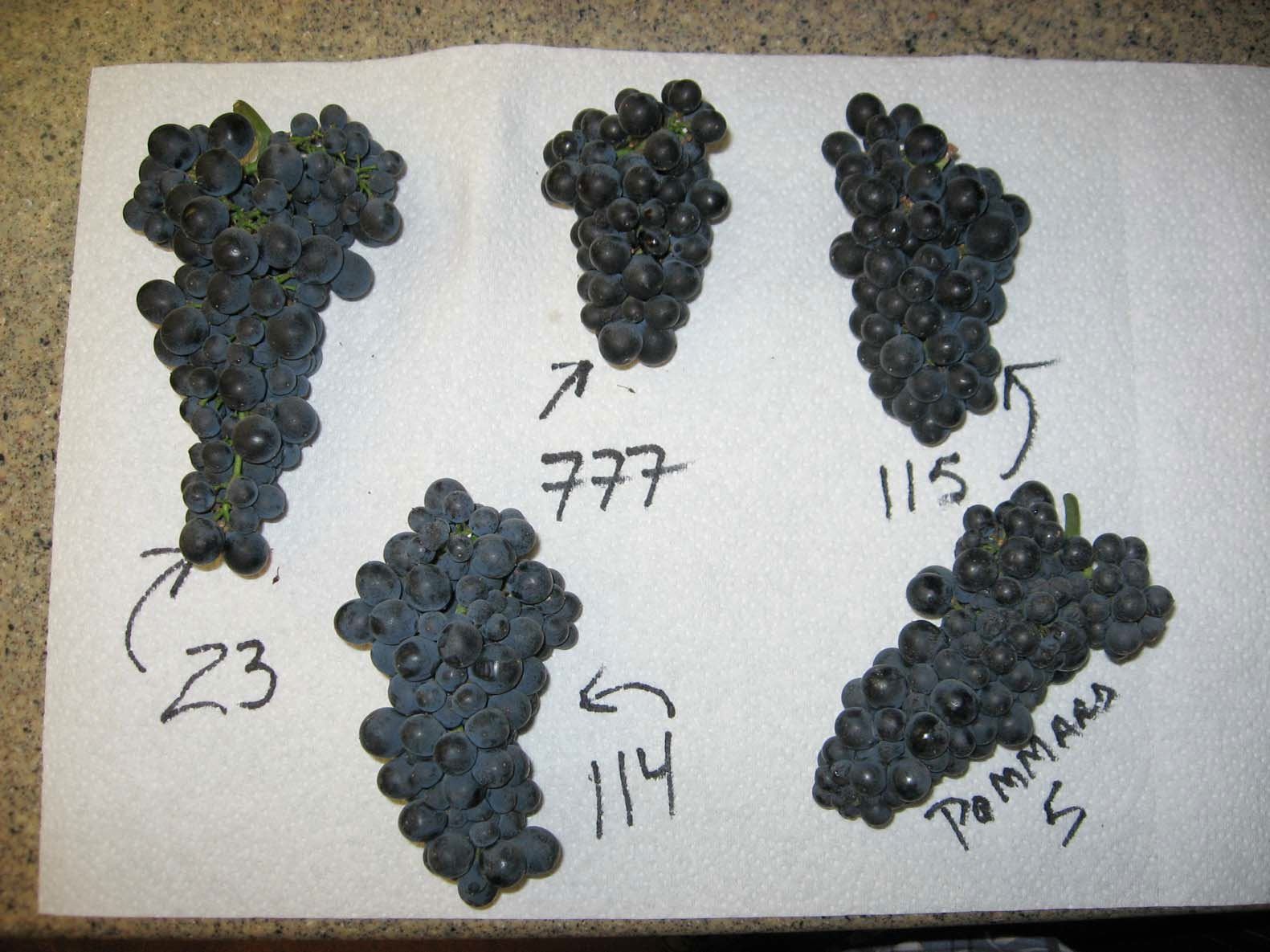
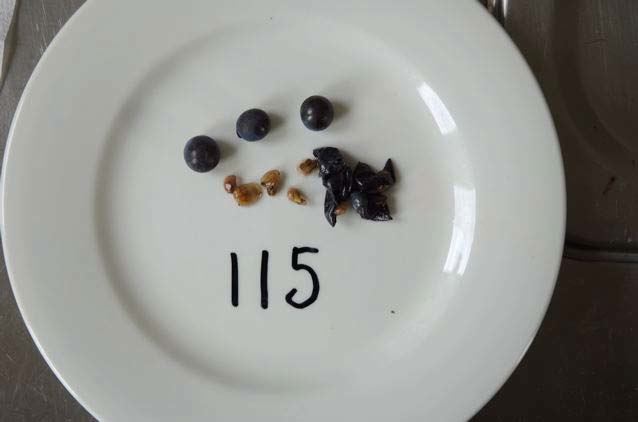
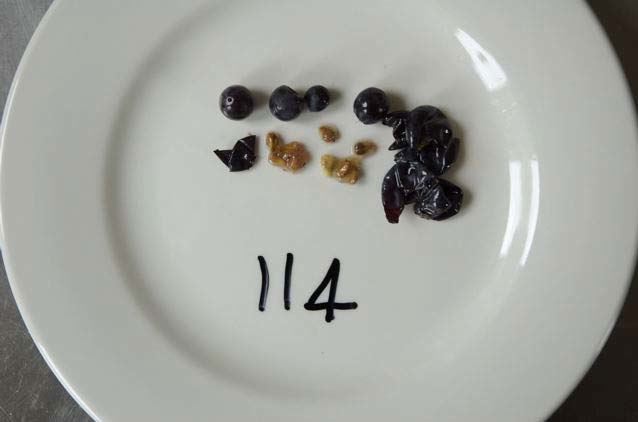
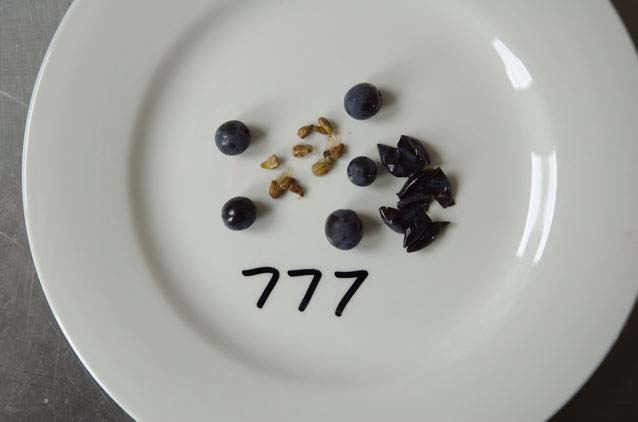
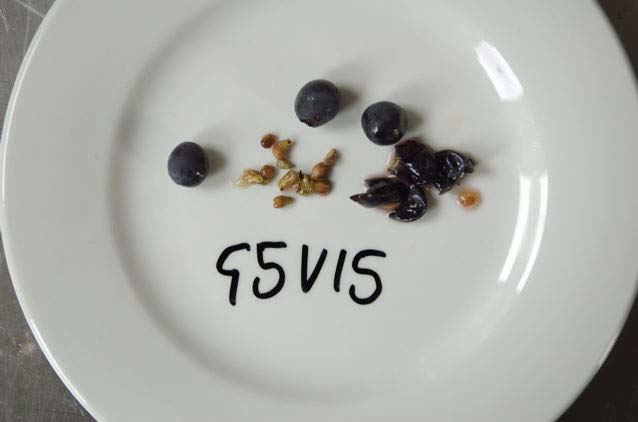 Clone 113 1971. Small to average cluster, small berries, strong color, most elegant of the Dijon clones, high and uneven yields, variable quality. Clone 114 1971. Small and compact cluster, small berries, very dark color, purple hue, rich aroma, good structure, tannic, classic Pinot Noir flavors of black cherry and spice, inconsistent from site to site, can be soft, forward and lovely or thin and hard. Shows precocious ripening with potential for higher degree of alcohol. Clone 115 1971. Most widely planted. Smaller, tighter cluster, little hand grenades, regular yields, strong purplish color, high anthocyanin, high pH, round, rich and supple, notable tannins, varietally consistent aromatic profile of black cherries, leather and roses, exotic flavors of cherries, blueberries, boysenberries and anise, age able. Can make an excellent and complete wine on its own and is valued for its balance and aromatic profile. Consistent from different locations. Bernard told Kelly that year after year wines made at the Lycée Viticole from clone 115 placed at or near the top of their evaluations until clone 943 came along. Clone 375 1974. Average cluster, compact, small to average berries, quality aroma, elegant and supple, limited age ability. Clone 459 Very little information. Sparsely planted in North America. Clone 667 1980. Big, tight compact cluster about the same size as 777, strong color, hi-tone and quality aromas, dark cherry, raspberry, strawberry, spice flavors, fleshy, firm, angular, thick but soft tannin. Variable quality depending on the site varying from green apple simplicity in warm sites where it accumulates sugar too quickly to deep Christmas spice mix (allspice, nutmeg, clove) in cooler sites. A workhorse structural clone, often de-stemmed. Clone 777 1981. Small, compact cluster, small berries, low-yielding, strong and intense color due to thick skins and higher seed count, very aromatic with dense and complex black fruit flavors (black cherry, cassis), with leather, tobacco, and earthy notes. Can be a powerful, monster of a wine almost Cabernet-like if not carefully farmed. Highly structured with tannin structure to age. Tannins are exaggerated in warm locations where sugar accumulates quickly, even more so than clone 667. More consistent than clone 667 and similar in character to clone 115. Clone 828 Little planted in North America, so information is mainly anecdotal. 828 was never certified for release in the United States because of issues with Redglobe virus. According to John Winthrop Haeger (North American Pinot Noir), Gary Andrus at Archery Summit imported cuttings from La Tache that were designated ASW2 and between 1997 and 2001, other wineries and growers in Oregon and California took cuttings of these vines and some was redistributed by nurseries. The selection became known as Dijon 828, but as Haeger notes, "Is almost certainly not." 828 remains in quarantine at University of California at Davis and has not officially been released by ENTAV in North America. Archery Summit has extensive plantings of ASW2 in their Renegrade Ridge, Red Hills and Looney vineyards which Haeger states, "Gives intensely flavored fruit with good color especially in marginal growing conditions." Small bunches and small to medium berries, dense color, low pH, high sugar production with earlier maturity than some clones. Possesses a fruit-forward character of blackberry and plum. Clone 943 Very small berries (among the smallest of all the Dijon clones), low seed counts, small clusters (smaller than clones 115 and 777), more open bunches, low yields, higher sugar content, intense flavors of red berry fruit. John Kelly reported that when he visited Bernard, he told him 943 was his favorite clone and that wines from clone 943 came out at the top of the tastings at the Lycée Viticole every year. One of the few Dijon clones where the French negotiated a royalty payment for every bud sold in the U.S. Kelly’s reaction after making wine from clone 943 in two vintages was enthusiastic. “The wines are dark, but elegant, and softer than wines from the other clones, perhaps due to the lower seed count. The aromas are amazing, ethereal unlike any of the other wines, and when I stick my nose in the wines, the pleasure centers in my brain light up with “PINOT,” yes, in all caps. That said, I would not make a stand-alone wine from clone 943 because the resultant wines would be too soft for my palate.” Kelly is a firm believer in using blends of Dijon clones in Pinot Noir. “From an optimistic (winemaker’s) viewpoint, the elements that each of the Dijon clones can bring to a blend will make a wine that is greater than the sum of its parts. From a more pessimistic (grower’s) perspective, working with a mix of clones is a hedge against any one of them failing in a particular vintage. Any way you shake it, clonal blends are a win-win.” The subject of Dijon Pinot Noir clones, or are any general discussion of clones for that matter, is amazingly complex. For those who wish to investigate the subject in more detail, I would suggest the following excellent references: North American Pinot Noir, John Winthrop Haeger; Clones of Classic Varieties: The Pinot Noir Portfolio, Nick Hoskins and Geoff Thorpe, www.riversun.co.nz (includes ENTAV-INRA® photos of clones); Catalogue of Grapevine’s Varieties and Clones Cultivated in France, available in English, www.oeno.tm.fr/librairie/Collection/Viticulture/Clones/ClonesSomm.en.html
Buena Vista: My House Red and WhiteIt doesn’t seem that long ago that Buena Vista Carneros was a ho-hum winery turning out 300,000 cases of average wine. Their best wine had become a Sauvignon Blanc made from grapes in Lake County, not from their extensive vineyard holdings in Carneros. The dramatic improvement in Buena Vista wines began with the acquisition of the winery by Beam Wine Estates and subsequently Ascentia Wine Estates and the hiring of winemaker Jeff Stewart, a master of cool climate varietals. The estate Ramal Vineyard underwent extensive replanting and upgrading beginning in 2003 with the initiation of sophisticated viticulture technology, and by 2008, Stewart had 800 acres of well-groomed Pinot Noir, Chardonnay, Syrah, Pinot Gris and Merlot to work with. Stewart, who is a very like able guy (with his tall, husky stature, beard and long curly hair, he reminds one of a happy-go-lucky mountain man), arrived at Buena Vista in 2003 and the full results of his efforts now show in the superb lineup of 2007 vintage wines.
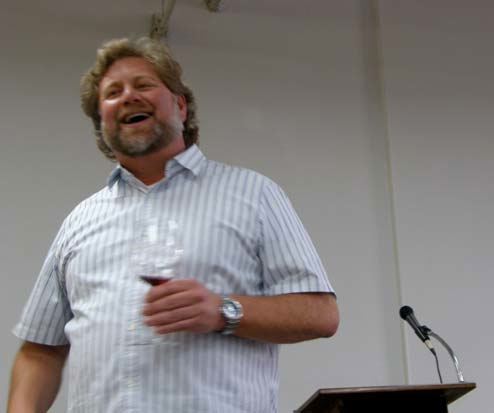 In 2004, the California Classic and Grand Reserve lines of Buena Vista wines were discontinued and production was decreased to 45,000 cases. Two new lines of wines were created: the Carneros Series which includes varietal bottlings of Chardonnay, Merlot, Syrah and Pinot Noir ($19-$25) and the Ramal Vineyard Series which features limited release wines of select clonal material or blocks from the property ($36-38). New packaging and labeling added a modern and sophisticated tone. Stewart has committed the entire Buena Vista lineup to screw cap closure. He says, “I am adamant in delivering the best expression of our vineyards. I believe this closure captures the pure Pinot Noir aromas and flavors and will deliver the best quality in the glass.” Stewart has access to 25 different clones of Pinot Noir. For the Carneros Pinot Noir reviewed below, grapes are hand picked at night to preserve the fruit character. The grapes are then hand sorted twice and gently de-stemmed. Each lot is cold soaked for a minimum of five days to maximize color and flavor extraction. The must is then fermented in small open-top fermentors. After an average of 14 days on the skins, the wine is pressed gently and aged for eight months in 33% new French oak with the balance in one to two-year-old barrels. The two wines reviewed below have become my “house” red and white wine of choice. So often neighbors, relatives and wine moochers drop by the house and I want to offer them a quality wine. The Buena Vista wines deliver a casual unpretentious choice at a sensible price that appeals to a wide audience. I don’t want to serve most people a $60 single vineyard Pinot Noir, because they simply don’t appreciate it (Buena Vista has sophisticated, ultrapremium Pinot Noir as well - see www.princeofpinot.com/article/809/). I prefer to offer them a solid, slightly flirty wine that is varietally correct and gives up its charms easily. Screw caps further enhance the casual and easy approachability of the Buena Vista wines. I taste many wines each year, but I can honestly say, these two wines offer the best bang for the buck of almost any comparably priced California wines. Phenomenal quality considering the large production, particularly for the Pinot Noir.
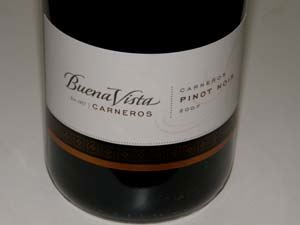 2007 Buena Vista Carneros Pinot Noir 13.5% alc., pH 3.64, 25,213 cases, $24.99. Released in July 2010. · Attractive perfume of spicy dark fruits underscored with oak. A forward wine offering typical Pinot flavors of dark raspberries, blackberries and cherries with a subtle spice note. Easy drinking with soft tannins and a welcoming silkiness on the palate, this wine packs in plenty of charm. Very good.
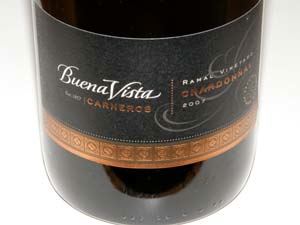 2007 Buena Vista Carneros Ramal Vineyard Estate Vineyard Series Chardonnay 14.2% alc., pH 3.43, 3,807 cases, $32, screw cap. Released in June 2010. Double Gold, Best of California, Best of Class (Tie) Sonoma Appellations, California State Fair Wine Competition. Clones are Dijon 96, RY 17, 15, 4 and Weimar. Whole cluster pressed. 100% barrel fermented, aged sur lies with the lees stirred every two weeks for 9 months. 100% MLF. Aged in 40% new French oak barrels with the balance one and two-year-old barrels. · Aromas of lemons, pears, buttered toast and roasted nuts. Very tasty essence of lemon curd, white peach, pear and a touch of allspice. Beautifully composed with a welcoming snap of acidity on the finish. A “go to” California Chardonnay that has all the spunk you can ask for.
Buena Vista Carneros wines are available on the website at www.buenavistacarneros.com and through retail channels. Buena Vista is the oldest California winery and its historic tasting room is open daily. Located a short distance from the winery (not open to the public) in the town of Sonoma. 800-926-1266.
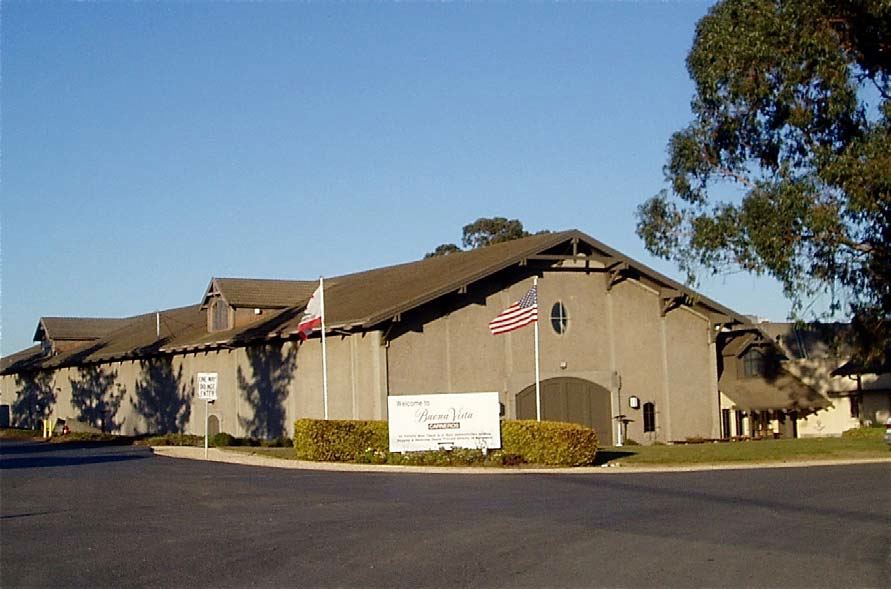
Lenné Estate: 2008s are Best EverAfter this year’s IPNC, I made my annual trip to the Yamhill-Carlton District of the Willamette Valley and met up with winegrower Steve Lutz at Lenné Estate. Steve has a special south-facing site on low vigor sedimentary and volcanic soils in a good neighborhood just east of the town of Yamhill that also includes WillaKenzie Estate, Shea Vineyard, Soléna and Grand Cru Estates, Soter and Beaux Freres. I discovered Steve’s excellent Pinot Noirs beginning with the 2006 vintage and have been a fan ever since. Steve and a group of investors began dense planting of Pinot Noir clones 115 and 777 and Pommard in their 20.9-acre vineyard in 2001 and launched Lenné Estate wines in 2002. Establishing the vineyard presented many challenges in part due to the steepness of the site and Steve’s insistence on dry farming, but he has persevered. Clones 114 and 667 were added in 2004-2005. The name, Lenné, pronounced “Lenay,” is a French adaptation of the name of Steve’s father-in-law, Len, who raised his family, including Steve’s spouse, Karen, on a chicken farm west of London, England. Len passed away in 1999, but he contributed part of the down payment on the vineyard, so it seemed only right to honor him. The Lenné Estate value bottling, Le Nez, features a side portrait of Len’s schnoz on the label and a silhouette of him appears on the Lenné Estate label. The first two vintages of Pinot Noir were released under the Le Nez label and the Lenné Estate label was added in 2006. The wines under the Lenné Estate label represent the best barrels from the vineyard in each vintage. Some clones stand out in certain vintages and they are bottled as clone-designated Lenné Estate Pinot Noirs. Lenné Estate wines are produced in collaboration with noted Oregon vintner, David O’Reilly. Some grapes are sold to O’Reilly’s own label, Owen Roe, but more are being retained for the Lenné estate wines. Production in 2008 was 1,300 cases. The wines are largely sold through a mailing list and at the quaint hilltop tasting room which is open on weekends or by appointment (503-956-2256). I tasted through the 2008 Lenné Pinot Noirs while sitting on the scenic tasting room deck (see photo below), as well as a few weeks later at my home. Steve told me the wines will not be drinking well until mid to late fall which is typical of many 2008 Oregon Pinot Noirs. The 2008 growing season was ideal at Lenné Estate, with perfect fruit set resulting in small, thick skinned berries. Cool weather prevailed with no rain. The resulting alcohols are all 14.0% at most. Steve finds consistent flavors of wild cherries, pomegranate, and mocha from his vineyard. The 2009 vintage will be more approachable early but will not be as long lived. I enjoyed tasting the wines now, but agree that the aromas and flavors are slow to come around, the impressive tannin structures need time to mellow, and the wines are best left in the cellar for another 6 to 12 months. All wines are unfined and unfiltered.
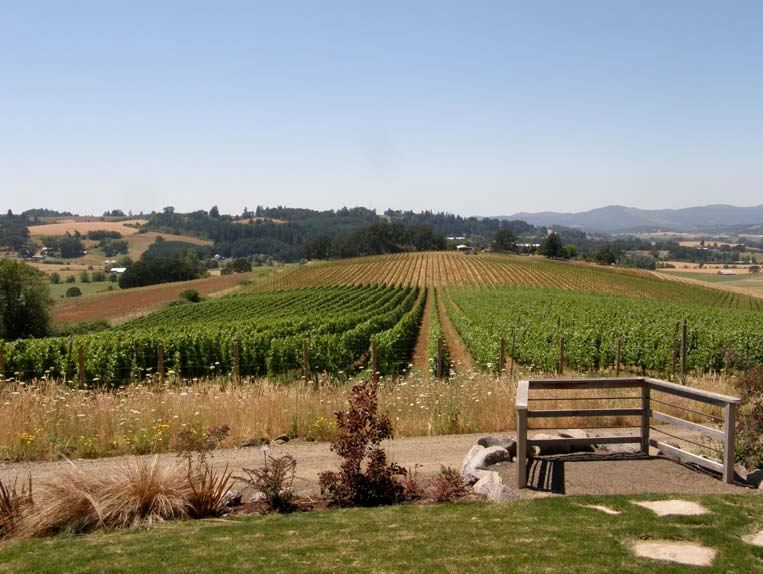 The 2008 Le Nez Pinot Noir and 2008 Lenné Estate Sad Jack have been released and the remainder of the lineup will be offered by September 1, 2010.
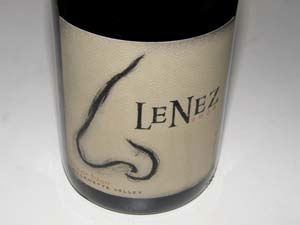 2008 Le Nez Willamette Valley Pinot Noir 14.0% alc., $30. All clones in the vineyard but primarily 777. The “infant” wine of Lenné Estate that is the most accessible wine in the 2008 lineup. · Expressive aromas of black cherries, berries and herbal tea. Tasty core of cherry and berry fruit of moderate intensity with a lovely touch of spice. Soft and elegant with pillowy tannins. Can drink now but will be even better in a year. Very good (-).
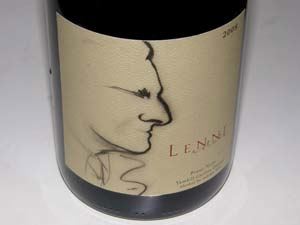 2008 Lenné Estate Yamhill-Carlton District Willamette Valley Pinot Noir 14.0% alc., 496 cases, $45. The best barrels of clones 115 and Pommard. · A panoply of different red and black fruit aromas including cherries, strawberries, and red currants with an underpinning of smoky oak. Flat out delicious array of pristine fruit including black raspberries and cherries. Lovely accents of loamy earth and mocha. Highly persistent aromatic finish. A seamless wine that is pure class in the glass.
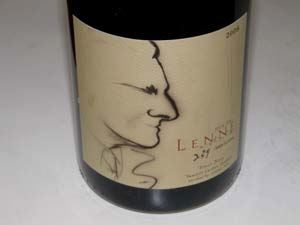 2008 Lenné Estate Jill’s 115 Yamhill-Carlton District Willamette Valley Pinot Noir 14.0% alc., 49 cases, $55. This wine has been very popular with tasters. · Shy but pleasing scents of red berries, cherries, pine pitch, wildflowers and mocha. Soft and smooth on the palate with notes of raspberries, strawberries, edible flowers and mocha java. A feminine Pinot that seduces with elegance. Doesn’t make a big flavor impression now but will improve with more time in the cellar. Very good.
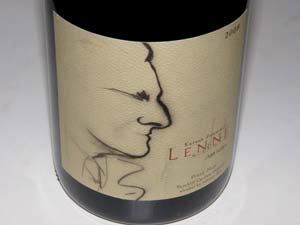 2008 Lenné Estate Karen’s Pommard Yamhill-Carlton District Willamette Valley Pinot Noir 14.0% alc., 49 cases, $55. · The nose really grabs your attention with aromas of pie cherries, wild berries, wooded forest, oak and cut flowers. Vivid black cherry fruit which is soft and luscious on the palate, persisting on the amazingly lengthy finish leaving a refreshing impression from lively acidity. Still has tannin to shed and the big gulp of fruit is reticent and linear at this stage, but this is a very polished wine that will be spectacular down the line.
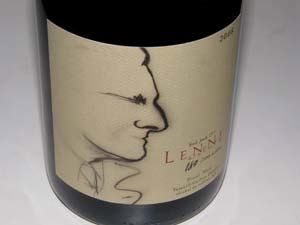 2008 Lenné Estate Sad Jack 777 Yamhill-Carlton District Willamette Valley Pinot Noir 14.0% alc., 49 cases, $55. Clone 777 does best in cool sites and 2008 was a very cool vintage so this clone really shined and some was bottled separately. Named after the two winery dogs, Sadie and Jack. · Restrained aromas of berry jam, rhubarb and rose petals. Similar in flavor profile to the Le Nez with more dazzling cherry, pomegranate and anise notes. Juicy and delicious, but not particularly expressive now, showing plenty of sinewy ripe tannins that need to integrate. Very good (+).
Domaine Drouhin Oregon: Burgundy’s First Footprint in OregonI haven’t written about Domaine Drouhin Oregon (DDO) in over two years since I attended a remarkable vertical tasting of DDO Pinot Noirs dating back to 1992 hosted by David and Janeen Lee of the website, www.loverofwine.com. DDO is a winery you almost take for granted since it has established a reputation of producing consistently stellar and age worthy wines over the years. I ran into David Millman, the Managing Director, at this year’s IPNC, and he invited me to stop by for a tasting. Maison Joseph Drouhin was the first, and to this day, the only Burgundy house with a serious Oregon commitment and the first Burgundy house to make wine outside of France. Robert Drouhin had visited the Willamette Valley first in 1961 and was struck by the resemblance of the region to the Côte d’Or. Subsequent visits and tastings of the early wines of Oregon’s pioneering winemakers convinced him that Oregon (not California) was the chosen spot for New World Pinot Noir. In 1987, Robert Drouhin bought 100 acres in the Dundee Hills overlooking the town of Dundee. He sent his daughter, Veronique-Boss Drouhin, to Oregon to learn about the region and she studied under David Lett at Eyrie Vineyards, David Casteel at Bethel Heights, and David Adelsheim at Adelsheim Vineyard. She began to craft the DDO wines (the first three vintages, 1988-1990 were from purchased grapes), and oversee planting of the vineyards beginning in 1988. Today there are 225 estate acres with 70 acres planted to Pinot Noir and 13.5 acres to Chardonnay. The first gravity-fed winery in Oregon was constructed at DDO in 1989 and much of the winemaking equipment was imported from Beaune. The vineyards at DDO are among the most densely planted in the United States. In 1988, when planting began, the norm in Oregon was 6’ x 8’-10’ spacing with typically 800 to 1,400 vines per acre. The initial vines planted at DDO were Pommard and Wädenswil clones on their own roots (no phylloxera-resistant rootstock was available at the time) with 1m x7’ spacing. In 1989, DDO transitioned to a 1m x 1.3m template creating an average of 3,300 vines per acre, with several Dijon clones (primarily 115 and 777) included in the plantings. DDO was among the first Oregon wineries to plant the new Dijon clones and use phylloxera-resistant rootstock. The Drouhins were disenchanted with the Wädenswil clone and this clone was eventually pulled out. Chardonnay came later. Phillipe, Veronique’s brother, has managed the vineyards from the beginning. DDO is one of the few vineyards in the country to cultivate their own rootstocks and propagate all their own plant material by selection massale.
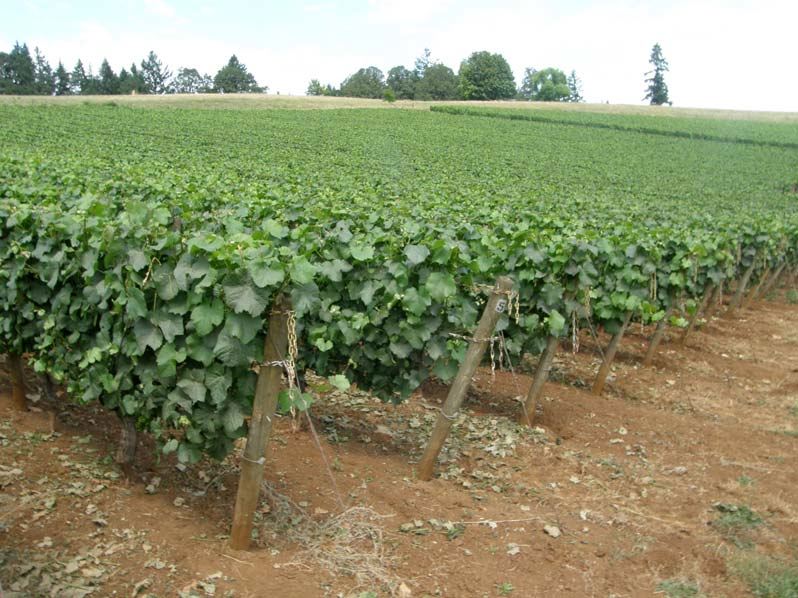
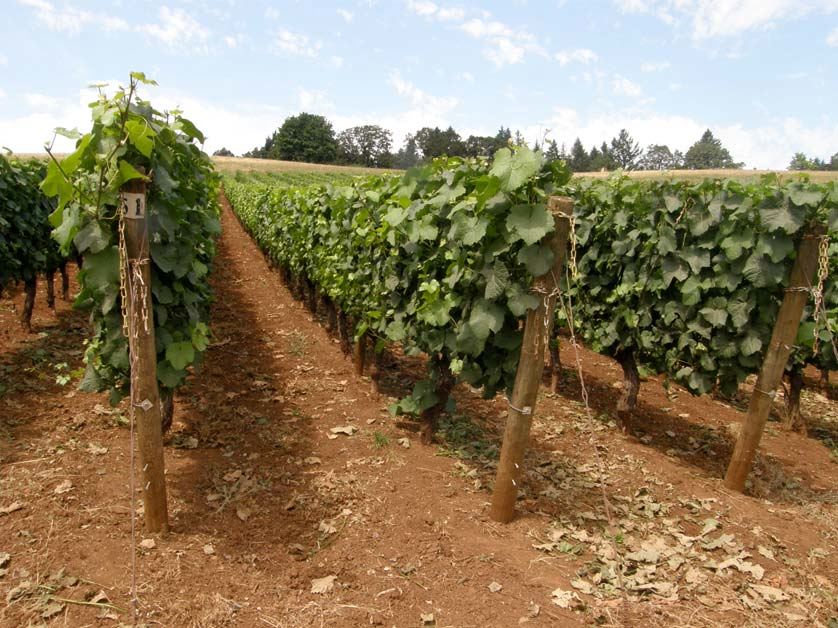 Over the years, Veronique Boss-Drouhin, also known as Vero by her friends, has been a long-distance winemaker, continuing to live in Beaune, and traveling periodically to Oregon to oversee DDO. Because of the difference in harvest between the Côte d’Or and the Dundee Hills of Oregon, she can supervise crush and fermentation in Beaune in September, overseeing 400,000 cases of Maison Joseph Drouhin wine production, and then fly to Oregon in time for crush which usually arrives in October. An on site winemaker at DDO works in close association with Veronique. The Pinot Noirs at DDO emphasize balance and elegance over robustness, and although they can be charming upon release, they age magnificently. The grapes are usually all de-stemmed and indigenous yeasts are employed. Oak character (new oak is at about 20%) is minmized. The wines are aged from 9 to 14 months in barrel. Veronique likes to say that the DDO wines are “Burgundian at heart, but with Northwest intensity.” The wines have more extraction and fruitiness than those from Maison Joseph Drouhin, but less extraction than many other Oregon Pinot Noirs. There are three Pinot Noirs at DDO. The Domaine Drouhin “Classique” is a Willamette Valley designate that is made from estate and purchased grapes (10,000 cases, $40) and is soft and accessible. This wine is released 2 years after the vintage. The Domaine Drouhin Cuvée Laurène has been made since 1992 and is named after Veronique’s first daughter who was also born in 1992. It was the winery’s first bottling of 100% estate fruit. The website refers to this wine as the winery’s “flagship wine.” This wine is a barrel selection with more structure, extraction and age ability (2,000 cases, $65). It is released 3 years after the vintage. The Domaine Drouhin Cuvée Louise was first produced in 1999 and is named after Veronique’s youngest daughter. This wine is a special selection of favorite barrels and is extremely limited (200 cases, $80), primarily sold to winery club members). The Louise has a little less structure than the Laurène, with more elegance and finesse. The Arthur Chardonnay, named after Veronique’s son, was first released in 1996 and is crafted in a restrained French style (2,500 cases, $30).
2009 Domaine Drouhin Oregon Rosé 14.1% alc., 450 cases, $20. The second time a rosé has been released at DDO. · Coral color in the glass. Bright peach and strawberry flavors with a crisp and refreshing finish. Will work beautifully with grilled salmon. Good.
2008 Domaine Drouhin Willamette Valley Pinot Noir 13.9% alc.. Unreleased. · Red in color in the glass. Oak supersedes the fruit aromas now with prominent coffee and toffee scents. Elegant and refined flavors of red berries and cherries with a touch of spice and sandalwood. Still young and tight but has the goods. Very good.
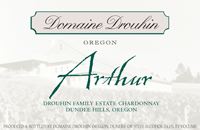 2008 Domaine Drouhin Arthur Willamette Valley Chardonnay 14% alc., $30. 100% estate fruit. Vinified 50% in stainless steel and 50% in barrel. · Pleasing aromas of white stone fruits, citrus and wet rocks. Demure flavors of white peaches and creme bruleé with no oak imprint and a bright, pure fruit finish. Always one of my favorite Oregon Chardonnays. Very good.
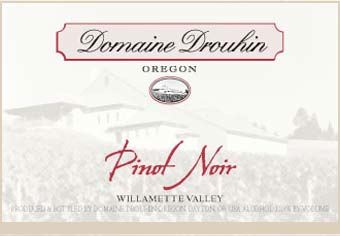 2007 Domaine Drouhin Willamette Valley Pinot Noir 13.9% alc., $40. · Bright berry perfume including blueberries. Moderately rich dark red fruits wrapped in soft tannins and brought to life with bright acidity. Like many Oregon 2007 Pinots, this one is drinking beautifully now and has the impeccable balance to age. Very good (+).
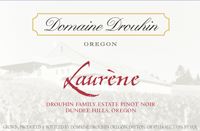 2007 Domaine Drouhin Laurène Pinot Noir 14.3% alc., 2,450 cases, $65. · Much more showy than the 2006 vintage with intense aromas of black cherries, cut flowers and lavender. The delicious dark red and plumy fruit attacks the mid palate with a vengeance, persisting lavishly on the pleasing finish. Has the tannic backbone and balancing acidity to easily go 12 years. Very good (++).
2006 Domaine Drouhin Laurène Pinot Noir 14.1% alc., $65. · Hi-tone aromas of cherries, garden herbs, dried rose petals and seasoned oak. A bit austere and tight offering more aromatics than flavors. There are plenty of red fruits undercover. Very good (-).
2004 Domaine Drouhin Willamette Valley Pinot Noir 14.1% alc.. · Array of pleasing aromas including cut flowers, Provencal herbs and strawberries. Juicy core of red berries and cherries with savory herbal notes leading to a dry finish. Still has plenty of life ahead. Very good.
The Domaine Drouhin Oregon tasting room at 6750 Breyman Orchards Road, Dayton, is open from 11:00 to 4:00 every day August 2 through October 12. Tours of the four-level winery are offered by appointment Wednesday through Sunday.
Spätburgunder
The Germans are in love with Pinot Noir, or as they call it, Blauer Burgunder, or “Blue Burgundian,” and the
marked improvement in quality in recent years has led to a widespread demand for it both in Germany and
abroad. The term, Spätburgunder, is used synonymously with Burgunder by the Germans and the Austrians
and Swiss. Spätburgunders were traditionally light red, sometimes sweet, wines, but in the last twenty years,
serious Burgundian-styled dry Spätburgunder has been made in the Rhine Valley of southwestern Germany.
The prime growing territory for Spätburgunder are the wine regions of Ahr, Mosel, Baden, Rheingau, and
Rheinhessen, areas best known for Riesling. Spätburgunder is the most widely planted red grape in Germany
and accounts for 11.5 percent of the country’s total vineyard area.
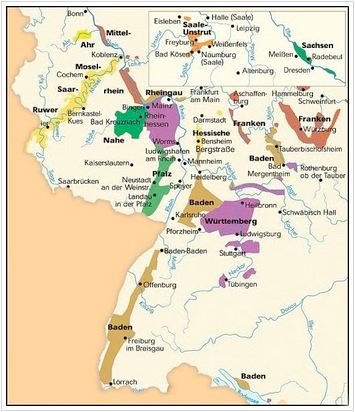 There is only a trickle of information available about German Pinot Noir and very little of the best examples reach the United States. I have had a few here and there and have not been impressed until I tasted the wines reviewed below. The standing joke about Spätburgunder has been, “Isn’t Spätburgunder the stuff the guys from Burgundy spat out?” With the 2000 vintage, Germany instituted the designations “Classic” and “Selection” to simplify matters for consumers. Classic wines can be from any of the 13 German winegrowing regions (see map above), the wines must be above average in quality, dry, and made from a traditional grape variety such as Riesling or Burgunder. The labels bear the Classic logo next to the name of the traditional grape variety. Vineyard names are omitted to leave the labels uncluttered and simple for the consumer. Selection wines are carefully chosen, best of the vintage wines from first-class vineyards where yields are low and harvesting is by hand. The wines must be bottle aged and dry for Burgunder varietals. In Germany, Burgunder clones that are resistant to botrytis are preferred. German clonal selections are divided into five groups: compact clones, loose-berried clones, mixed clones, upright-growing clones, and small-berried clones. The compact clones include the Dijon clones such as 113, 114, 115, 667, 777, 927, 792, 872, 870 and 386, all of which have some resistance to botrytis. They are usually planted on flat, dry sites. The loose berried clones (includes the Mariafeld clones from Wädenswil) are more resistant to botrytis but in most years, the quality of the compact clones outweighs the advantage of better botrytis resistance of the loose-berried clones. The upright-growing clones are used for sparkling wine and Pinot Noir vinified as a white wine. The small-berried clones come from Freiburg and Geisenheim and are well suited for producing high value red wines. Due to good botrytis resistance, these clones can be planted in deep and rich soils. There is high demand for these clones in Germany and they are in limited supply. The bible on German wines is the Gault Millau WeinGuide Deutschland but it is published only in German and not available in the United States. This is a shame since it offers ratings on the best producers and extensive reviews and ratings of wines. An excellent source of information on German wines is Schiller Wine, the blog of Christian G.E. Schiller, a German living in America (www.schiller-wine.blogspot.com).
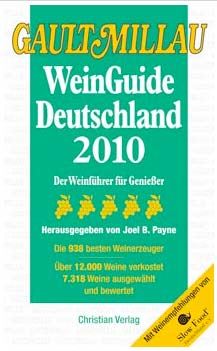 Schiller noted recently (www.schiller-wine.blogspot.com/2010/03/germanys-top-winemakersfeinschmecker. html) that the German wine industry consists of about 70,000, mostly small, wine producers. If hobby winemakers are excluded, the number is reduced to 30,000 wine makers. If you include only full-time wine producers with a minimum of 5 hectares, it leaves about 6,000 wineries. Large wineries are rare in Germany. Quality Spätburgunder wines are difficult to source in the United States. I found several of the wines reviewed below through K&L Wine Merchants in California (www.klwines.com). Another source is Truly Fine Wine which sells exclusively German wines (www.trulyfinewine.com). Prices run the whole gamut, much like New World Pinot Noir, but high quality examples can often be quite expensive. Try Spätburgunder - you will be pleasantly surprised!
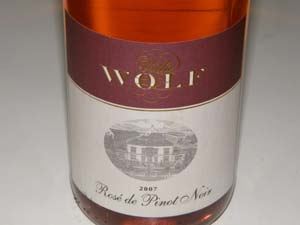 2009 Villa Wolf Pfalz Germany Rosé de Pinot Noir 11.5% alc., $11. Imported by Anne’s Boutique Wines, Costa Mesa, CA. Produced by Ernst Loosen. · Moderately deep orange-coral color in the glass. Faint aromas of oranges, strawberries and rose petals. Tasty and mildly rich on the palate with appealing flavors of fresh oranges, tart berries and vanilla cream. A fine example of a Pinot Noir rosé. Very good.
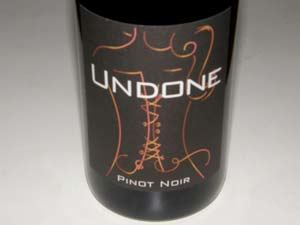 2008 Undone Rheinhassen Germany Pinot Noir 13.0% alc., $13, screw cap. Imported by Valckenberg International Inc., Tulsa, OK. Unoaked. Label shows an unraveling corset and the words, “Smooth, dry, naked flavor.” · Moderately light reddish-purple color in the glass. Welcoming aromas of black cherries, red and black berries and cut flowers. Light, elegant and charming on the palate with an array of flavors including cherries, raspberries, boysenberries, red licorice and baking spices. A tasty, easy drinking, handy wine in an impressive package at an exceptionally good price. Very good.
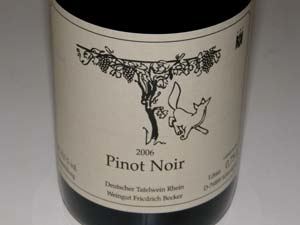 2007 Weingut Friedrich Becker Deutscher Tafelwein Rhein Germany Pinot Noir 13.5% alc., $17. Imported by Cellars International Inc., San Marcos, CA. · Moderate reddish-purple hue in the glass. Attractive perfume of dark berries and toasty oak. Bright and juicy flavors of mixed berries with a hint of citrus on the persistent finish. Soft in the mouth with gossamer tannins. A very classy wine that was even more incredible the next day from a previously opened and re-corked bottle. Achtung! An unbelievable value and highly recommended.
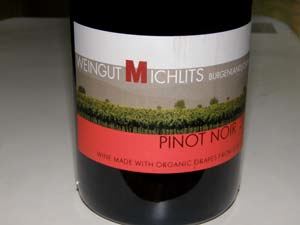 2007 Weingut Michlits Burgenland/ Österreich Austria Pinot Noir 14.0% alc., $20. Imported by Presscott Wines Inc., NY, NY. Made from organic grapes. · Moderately dark garnet color in the glass. A panoply of dark berry aromas clothed in toasty oak. Impressively rich mid palate attack of black cherry and black raspberry fruit with a hint of cola. Comforting mouthfeel with mildly aggressive tannins and bright acidity. Better over time in the glass. A charming wine that should benefit from even more time in the cellar. Very good.
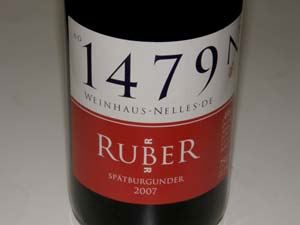 2007 Weinhaus Nelles De Ruber Spätburgunder Trochen AD 1479N Ahr German Pinot Noir 13.5% alc., $22. Imported by WineSellers, Ltd., Skokie, Ill. · Moderate color. Crazy about the nose which is flush with black cherry, ripe strawberry and underbrush aromas that keep getting better and better over time in the glass. A smooth, soft, fruit-driven wine rich with cherry and berry fruit accented with a gentle touch of oak. On the lighter side with mild tannins and respectable finesse. The nose trumps the flavors and the finish falls off quickly, but still a solid wine. Very good (-).
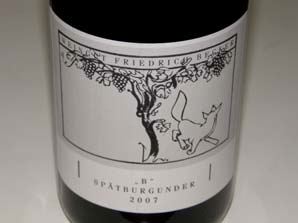 2007 Weingut Friedrich Becker “B” Spätburgunder Pfalz Germany Pinot Noir 13.0% alc., $42. Imported by Cellars International Inc., San Marcos, CA. · Moderate reddish-purple color in the glass. The nose is intensely fruity and hi-toned featuring scents of black cherries, spice and old cask. Discreetly concentrated blackberry jam essence with hints of black tea and oak. Soft tannins and balancing acidity. Picks up interest and power with time in the glass. Even better the next day from a previously opened and re-corked bottle. Very impressive wine with age ability.
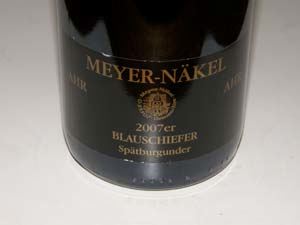 2007 Meyer-Nuäkel Blauschiefer (“Blue Slate”) Spätburgunder Ahr German Pinot Noir 13.5% alc., $45. Imported by Cellars International Inc, San Marcos, CA (Rudi Wiest). · Moderate reddish-purple color. Lovely perfume of wild berry compote, dried rose petals, tobacco and wet earth. A serious wine with a savory bent. Dense, darkly fruited and earthy with restrained tannins and a very sensual mouth feel. Assumes more intensity and interest over time in the glass. Very good (+).
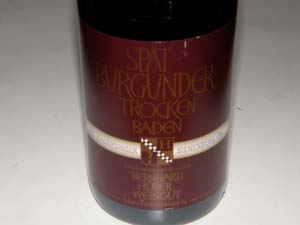 2005 Weingut Bernhard Huber Spätburgunder Trochen Baden Germany Pinot Noir 13.5% alc., $60. Imported by Valckenberg International Inc, Tulsa, OK. · Moderately intense reddish-purple color in the glass. The nose lacks fruit, emphasizing aromas of wine cellar, oak char, petrol and ash. A decent core of darker fruits is over ridden by notes of oak, earth and mushroom. Modest richness with soft tannins, a smooth texture and a dry finish. Decent.
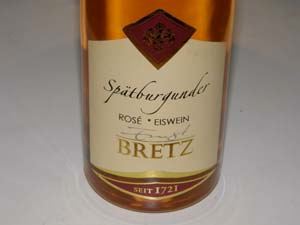 2004 Weingut Ernst Bretz Spätburgunder Rosé Eiswein 8.0% alc., $33, 375 ml. Imported by WineSellers Ltd., Skokie, Ill. · Golden apricot color in the glass. Aromas of lemon curd, white stone fruits and roasted nuts. Delicious and intense core of white peaches and apricots with a hint of strawberries that lasts and lasts. Slightly viscous. A real treat especially at this low alcohol level. A great wine for those with a sweet tooth. Tastes similar to a late harvest Pinot Gris (a good wine to fool your friends with as they would never guess this wine is Pinot Noir). Very good (+).
Robert Sinskey VineyardsRobert Sinskey, M.D., was an ophthalmologist practicing in Santa Monica in the early 1970s when I was an ophthalmology resident at UCLA’s Jules Stein Eye Institute. We operated together several times and enjoyed a few social repasts. Sinskey went on to indulge his passion for wine, initially as an investor in Acacia Winery in 1980 in Carneros, and later in 1988 as an owner of his eponymous winery which is now located in the Napa Valley. From a small holding of 15 acres of vineyards, Robert Sinskey Vineyards (RSV) has grown to just under 200 acres of prime vineyard land in five Napa Carneros locations, and a small 4.8-acre estate vineyard adjacent the winery in the Stags Leap District of the Napa Valley. Beginning in 1991, the vineyards were all farmed organically and biodynamically (they are now all CCOF certified organic and Demeter® certified biodynamic). Robert Sinskey’s son, Rob, early on successfully took over the winery operations and winegrowing duties. The winemaker since 1991 has been Jeff Virnig who was trained at Cafaro, Mayacamas and Joseph Phelps. Pinot Noir has been the focus of the winery, but the road to success with this fickle grape has been rocky as Rob notes on his website. “Pinot Noir became my muse. She scared and thrilled me at the same time. I didn’t always understand her, but I intuitively knew that if we provided for her, she would reveal her subtle and elegant beauty. She had no qualms, however, about telling us when we made mistakes. At times, she gave us the silent treatment, closing in on herself, tight lipped and determined to reveal little; or she might throw a fit, hurling an aromatic assault of tomatoes, medicine chest and rubber tennis shoes. The worst was when you missed the mark by showing up late (to harvest) and discovered your delicate Pinot shriveled up like a beauty queen who had spent her better years tanning at the beach, now prematurely aged, brown at the edges with a tired essence of prune.” Years of experience combined with a commitment to organic and biodynamic winegrowing have brought RSV wines considerable well-deserved praise. Most of this recognition has come from wine geeks in the know, since RSV does not tout wine reviews or scores. Pinot Noir has been produced at RSV since 1986 (the first vintage was from purchased fruit) and includes a Los Carneros appellation blend, three vineyard-designate bottlings and a Reserve called Four Vineyards containing primarily Three Amigos Vineyard fruit. The winery is famous for its outstanding Vin Gris of Pinot Noir, among the best in California. The Pinot Noir from RSV is atypical for California. Grapes are picked early, new oak is kept to a minimum (25% to 30%), some wines are fined, and typically the wines remain in bottle for 12 to 24 months before release. The wines are usually less than 14.0% alcohol, elegantly styled, with lively acidity, modest extraction, and no encumbrances from oak and tannin. They are about as far from Caliesque fruit bombs as you can get in California. The 2007 Pinot Noirs reviewed below represent the winery’s twenty-second vintage of Pinot Noir. In every wine tasted, the aromatics were currently introverted and lagged the flavors in charm. The house style is very conducive to food and I find it more akin to Oregon than California. The RSV tasting room at 6320 Silverado Trail is off the beaten path for pinotphiles, but is a favorite of Sunset and Wine Spectator magazines, and worth a trip. It is open daily from 10:00 to 4:00. The wines are also sold online where the informative website aims to educate (www.robertsinskey.com). A third 2007 vineyard designate Pinot Noir from Capa Vineyard was not reviewed as it has not been released. A Merlot, Zinfandel, Cabernet Franc and Cabernet Sauvignon are also produced. Visit the informative website section called “Vineyard Kitchen” for seasonal menus and recipes from Maria Helm Sinskey, Rob’s spouse, who was formerly the executive chef at San Francisco’s Plumpjack Cafe. Her recipes also accompany each of the RSV wine tasting notes and I found myself drooling after looking at the accompanying photos.
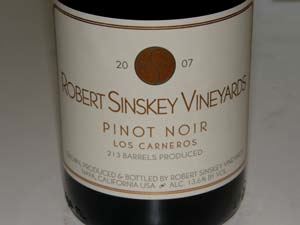 2007 Robert Sinskey Vineyards Los Carneros Pinot Noir 13.6% alc., 5,325 cases. $38. · Lovely perfume of black cherries, violets, pine pitch and graham. Soft and silky in the mouth with bright red plum, cranberry, red currant and black cherry flavors with side notes of cola and brioche. The fruit is caressed by fine grain tannins and zingy acidity that perks up the tangerine-laced and slightly tart finish. Very good.
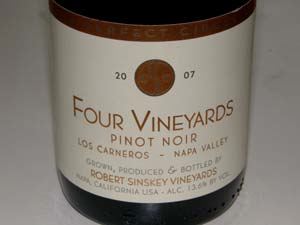 2007 Robert Sinskey Vineyards Four Vineyards Los Carneros Napa Valley Pinot Noir 13.6% alc., $56. Chosen from as many as 30 different lots of Pinot Noir from RSV’s four Pinot Noir vineyards. · Moderately dark ruby in the glass. Very shy initially, opening slowly with coaxing over time in the glass revealing alluring aromas of dark red cherries and berries and underbrush. Follows the same theme as the other Pinot Noirs in the lineup with delicious bright dark red and black fruits, some hints of gourmet red, hard cherry candy and sandalwood, and a zippy finish showing hi-tone citrus peel aromas. Modestly intense and rich, displaying well-integrated tannins, a gentle nature, and the most generous, powerful and persistent finish in the RSV lineup. A seductive wine that is hard to say no to.
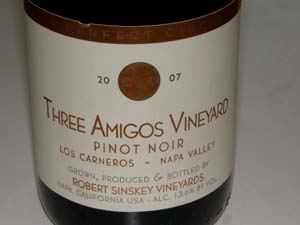 2007 Robert Sinskey Vineyards Three Amigos Vineyard Los Carneros Napa Valley Pinot Noir 13.6% alc., pH 3.48, $56. This vineyard was planted to heirloom (heritage) selections beginning in 1982. Aged 9 months in 40% new French oak barrels. · Moderately dark ruby color in the glass. Very shy nose initially revealing demure scents of dark red fruits, dried oak and smoke. More showy on the palate with juicy and earth-kissed red cherries and berries. Ripe tannins provide some backbone and the bright acidity lifts the fruity finish. Very good (+).
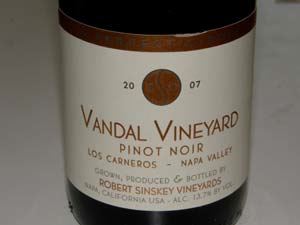 2007 Robert Sinskey Vineyards Vandal Vineyard Los Carneros Napa Valley Pinot Noir 13.7% alc., $56. A selection of five lots from the Vandal Vineyard which is located on a ridge of land in lower Carneros that joins the shoulder of Mt. Veeder. · Moderately dark ruby color in the glass. Very shy aromas of dark red and black fruits with a hint of toast and crackers. More expressive in the mouth with bright flavors of earthy darker fruits and hints of cherry skin and orange peel on the finish. Firmly structured but smooth and sensual. Will benefit from additional cellaring. Very good.
Raiding the Library of the Pinot Carzina: Lane Tanner Pinot Noir, 1988-2007
most responsive, delicate, fickle, fragile grape to work with - and I’m hooked on it.” Lane Tanner Several friends joined me recently for summer “Pinot Camp” in the Sta. Rita Hills. We visited Sea Smoke, Clos Pepe (for their annual barrel tasting) and dined with both Lane Tanner of Lane Tanner Winery and Jeff Fink of Tantara. A highlight of the weekend was a special dinner with Lane Tanner at Root 246 restaurant located in Hotel Corque in Solvang. Lane was in fine form, embracing her rule of life to “Laugh more, flirt often,” and generously offered us the chance to raid her library of Pinot Noirs. I had such a great time that I misplaced my tasting notes, not that they were very extensive to begin with. Suffice it to say that Lane Tanner’s Pinot Noirs age extremely well. The older wines, dating back to 1988, were phenomenal out of magnum and still holding their own in the 750 ml format.
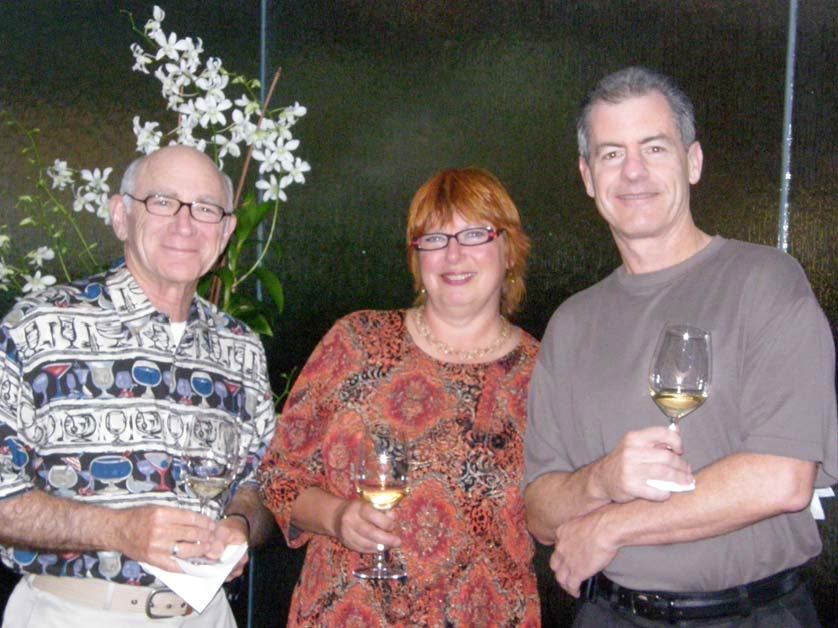 Lane Tanner originally had no intent to make wine. In need of a job, she found herself at Konocti Winery in Lake County on the bottling line in the mid 1970s. Her boss found out she had a degree in chemistry and put her in the lab. The first day she was in the lab, she was introduced as the new enologist to the winery’s consultant, Andre Tchelistcheff. The only problem was that Lane had no clue what an enologist did. She was asked to sit in on a tasting of wines with the winery owner and Tchelistcheff and had to fake her way through as she had never participated in a formal tasting before. In spite of her self-perceived ineptness, Tchelistcheff took a liking to her, urging the winemaker to, “Have Lane test this, have Lane test that.” Her experience with Tchelistcheff led to her interest in winemaking and her currant alias, “Pinot Czarina.” Lane moved on to Firestone Winery in Santa Barbara County, married Frank Ostini of the Hitching Post II restaurant and produced Pinot Noir for the restaurant from 1984 to 1989. Upon their breakup, she launched her own label, Lane Tanner Winery, at a time when there were very few women winemakers in California. She now produces approximately 1,500 cases of Pinot Noir at Central Coast Wine Services in Santa Maria. Her style of winemaking is distinctive in that she picks earlier than most vintners, avoiding high and intrusive alcohol at all costs, and strives for elegance and bright acidity. Oak treatment is understated, with less than 30% new French oak used during the 12 to 18 month elevage in barrel. The style does not appeal to everyone, but those in attendance at the dinner came away with an appreciation of the consistent high quality through almost 20 vintages and the ability of the wines to charm after many years in bottle. Lane is a one-woman winery, doing everything herself. You won’t find her wines prominently promoted (except in the PinotFile), but pinotphiles know to buy everything she makes every year. Lane Tanner is one of the few wineries to have a library of older vintages for sale. Below is a listing of the wines we tasted with dinner, with my favorites starred. Some of these wines are still available for purchase at www.lanetanner.com although several of us bought out a few cherries from past vintages.
1991 Lane Tanner Sanford & Benedict Vineyard Santa Barbara County Pinot Noir ਭ1993 Lane Tanner Sanford & Benedict Vineyard Santa Barbara County Pinot Noir Magnum
 1992 Lane Tanner Santa Barbara County Pinot Noir ਭ1994 Lane Tanner Bien Nacido Vineyard Santa Maria Valley Pinot Noir 1999 Lane Tanner Bien Nacido Vineyard Santa Maria Valley Pinot Noir Magnum ਭ2000 Lane Tanner Bien Nacido Vineyard Santa Maria Valley Pinot Noir Magnum 2003 Lane Tanner Melville Vineyard Sta. Rita Hills Pinot Noir ਭ2003 Lane Tanner Bien Nacido Vineyard Santa Maria Valley Pinot Noir Magnum
 2005 Lane Tanner Bien Nacido Vineyard Santa Maria Valley Pinot Noir ਭ2007 Lane Tanner Bien Nacido Vineyard Santa Maria Valley Pinot Noir
LIOCO Winery: A Different PathSommeliers approach wine from a different perspective, less focused on the hedonism of wine and more concerned with how the components of wine act in unison to compliment and enhance the experience of dining. Their profession teaches them about what kind of wine makes food sing. It is no surprise, then, that in recent years many sommeliers have launched their own wine labels, directing the crafting of wine or even making wines themselves that reflect their preference for food-loving wines. Many sommeliers have established intimate relationships with winegrowers and winemakers through the years, making it easy for them to gain access to talented people in the wine business to assist in the start up process. One of these sommeliers is Kevin O’Connor of Spago Restaurant in Los Angeles. O’Connor predates the current surge in sommelier wine producers, having made wine for years under the O’Connor label. Beginning with the 2005 vintage, he teamed with former North Berkeley Imports wine importer Matt Licklider to found the LIOCO label, specializing in non-manipulated site-driven wines. LIOCO is a combination of the partner’s last names. O’Connor works closely with University of California at Davis graduate Kevin Kelley (pictured below), who also crafts wines for Salinia Wine Company, Heintz Vineyard, and Spot-On Cellars. Like a number of winemakers who started out with ambitions to enter the medical profession, he was derailed after reading Charles Sullivan’s Like Modern Edens, the story of the origins of the Santa Clara Valley wine business. After serving an internship at Domaine Meo-Camuzet in Burgundy, he became an assistant winemaker under Wells Guthrie of Copain. He founded his own label, Salinia Wine Company, with his wife Jennifer in 2003, with the intention of producing wines with minimal winemaking imprint using indigenous yeasts and very little to no oak (only seasoned oak barrels are used). To achieve his goals, he picks early, does not temperature control fermentations, avoids fining and filtration, minimizes sulfur usage, and lets nature take its course.
 The LIOCO Chardonnays fermented in stainless steel and the non or barely-oaked Pinot Noirs are a revelation. The food-loving style will appeal to winos who like their wines lean and bright. LIOCO produces about 12,000 cases annually of what Kevin likes to call “honest” wine out of a facility in a Santa Rosa, California industrial park. LIOCO Wines are available on the website at www.lioco.com, at select restaurants, and at fine retail wine stores. The labels are highly informative detailing the winemaking, the tasting profile, and all the pertinent scoop (see below). Most of the wines reviewed below are still available on the website. The 2009 Sonoma County Chardonnay ($20), 2009 Carneros Chardonnay ($30), 2008 Demuth Vineyard Chardonnay ($35), and 2008 Charles Heintz Chardonnay ($45) are now offered. There is also a Rosé of Pinot Noir ($14), and a Indica (blend of old-vine Carignan and Petite Sirah) wine ($20) and Indica Rosé ($14). The winery’s business office is in Los Angeles (310-717-1892).
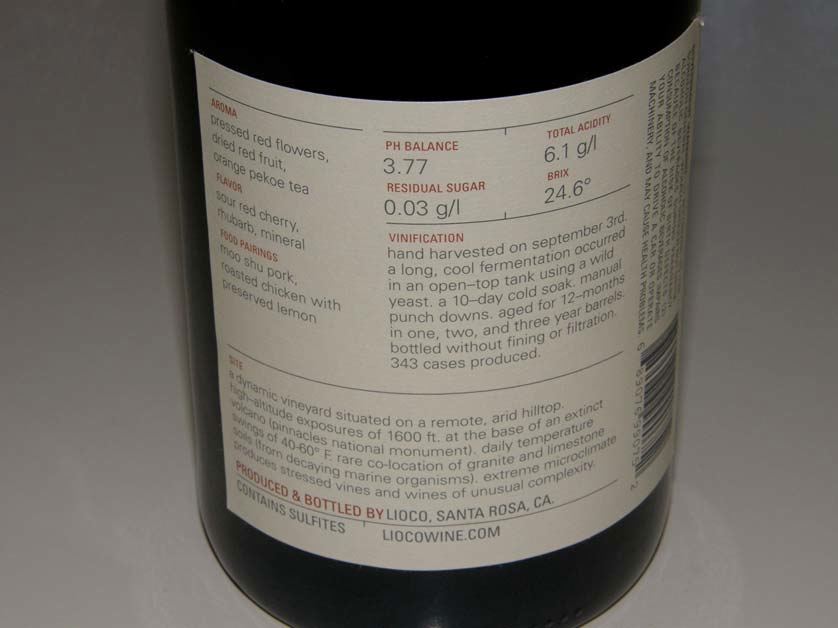
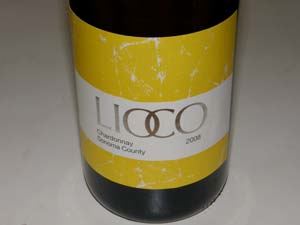 2008 LIOCO Sonoma County Chardonnay 13.5% alc., $20, screw cap. Fermented in stainless steel sur lie for 5 months, wild yeast, 100% MLF. · Straw color in the glass. Aromas of lemons, ocean air and brioche with a little funkiness that persists in the glass. The flavors trump the aromas with tasty baked apple, pear, dark toffee notes. Slightly creamy with bright acidity. Good.
2008 LIOCO Sonoma Coast Pinot Noir 14.0% alc., pH 3.71, $35. Clones 115 and 667 from vineyard in the Petaluma Gap. 7-day cold soak, 20% whole cluster, wild yeast fermentation, aged 11 months in neutral oak, unfined and unfiltered. · Heavy scent of crushed black cherries and allspice. A bit tart and lean for my taste with a blast of citrus on the dry finish. Improves some over time in the glass and I would recommend pounding it in a decanter and drinking it with food. Decent.
2008 LIOCO Graham Family Vineyard Green Valley of Russian River Valley Pinot Noir 15.2% alc., $40, screw cap. · Penetrating and haunting aromas of red plum, red berries, violets and graham. Lip smacking hedonistic core of sweet red berries that are nicely spiced. The attack is impressive and the fruit is startling good. This is a perfect sipping wine, the fruit hanging around on the finish for at least half a minute. Very Caliesque and atypical for the LIOCO style. The alcohol is well-integrated and the wine was still drinking well the next day from a previously opened and re-corked bottle indicating spot on balance.
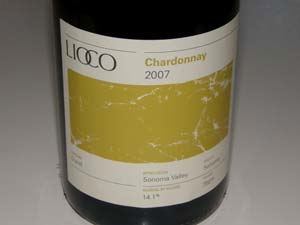 2007 LIOCO Durell Vineyard Sonoma Valley Chardonnay 14.1% alc., pH 3.81, 160 cases, $35. Whole cluster pressed, cold fermented, no oak, wild yeast fermentation, natural MLF, aged 6 months sur lie in stainless steel, unfined and unfiltered. · Golden yellow color in the glass. Complex aromatic profile offering scents of crushed rock, papaya, lychee, petrol and smoke. Discreetly rich and slightly viscous with flavors of lemon peel, white peach, Asian pear and melon. The wine’s modest acidity reflects a warmer site. Very good.
2007 LIOCO Sonoma Carneros Pinot Noir 14.2% alc., 504 cases, $35. From a vineyard near the Napa/Sonoma border exposed to cool winds and fog from San Francisco Bay. 7-9-day cold soak, 16- day fermentation in open-top tanks, wild yeast, aged 12 months in neutral barrels, unfined and unfiltered. · Lovely perfume of plums, currants, spice and a whiff of oak. An impressive wine that captures the essence of dark stone fruits and grapes. I was captivated by the purity of this wine and the generous finish that lingered for over twenty-seconds.
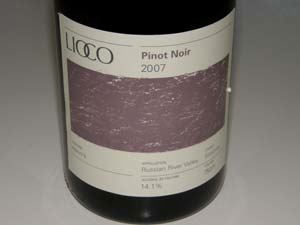 2007 LIOCO Henni’s Vineyard Russian River Valley Pinot Noir 14.1% alc., pH 3.74, 45 cases, $45. This vineyard is in a cool site in Green Valley, planted densely (4’ x 4’) on Goldridge soil. This wine is from the first harvest at this vineyard (“Virgin Vintage”). 7-day cold soak, long (19 days), cool wild yeast ferment in open-top tanks, manual punch downs, aged 12 months in once used oak barrels, unfined and unfiltered. · The aromas of berry tart, Asian 5-spice, and warm brioche really come at you from the start. Would make a very sensual perfume. Pure flavors of red berries and cherries, pomegranate, spice, and a subtle Concord grape note. Unencumbered by oak flavors and tannins, this wine is both exotic and erotic.
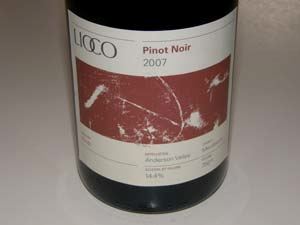 2007 LIOCO Klindt Vineyard Anderson Valley Pinot Noir 14.4% alc., pH 3.80, 265 cases, $45. A diverse mixture of clones. · Nicely nuanced nose showing aromas of black cherries, balsam, spice and melon. Tasty core of cherries and berries with a touch of spice, savory herbs, pine tar and savory herbs. Clean, smooth, nicely balanced, and opens smoothly over time in the glass. Very good (-).
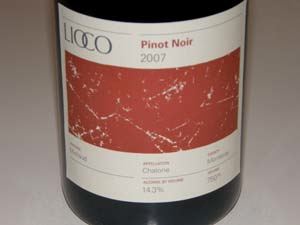 2007 LIOCO Michaud Vineyard Chalone Pinot Noir 14.3% alc., pH 3.77, 343 cases, $48. This vineyard is located at an elevation of 1,600 feet on granite and limestone soils. The climate is extreme, with 40 to 60 degree diurnal shifts, resulting in stressed vines. 10-day cold soak, aged 12 months in 1, 2, and 3- year-old oak barrels, unfined and unfiltered. · Deeply colored. Appealing, even ridiculously sensual aromas of warm cherry tart, tea, ground savory and dark roses. Flavors of loamy black cherries and berries, spice and grilled mushrooms. A sweet and sour thing is going on with the fruit. Silky and smooth with healthy ripe tannins yet a charming elegance. Amazing persistence of berry fruit on the generous finish. This wine will stand up to hearty foods. Very good (+).
Sta. Rita Hills: California’s Best AVA for Chardonnay?Chardonnay is most likely the result of an amorous fling in the distant past between Gouvais Blanc and Pinot Noir. I like the result of this Pinot Noir infidelity and when I am not drinking Pinot Noir, I can usually be found with a glass of California Chardonnay in hand. I enjoy all styles, but I prefer three-quarters to full throttle oak imbued, buttery, 100% MLF Chardonnay grapes when I am just sipping. I go for the combo of stainless steel and oak fermented style when dining. A large portion of the aromas and flavors of California Chardonnay come from the winemaking, but differences in regional climate are an important factor. In recent months I have had marvelous Chardonnays from the Sonoma Coast (Hirsch Vineyard, Mendocino Ridge), Russian River Valley (Ritchie Vineyard, Heintz Vineyard), Mayacamas Mountains (Hanzell), Carneros (Ramal Vineyard), Santa Maria Valley (Solomon Hills Vineyard), and Sta. Rita Hills (Sea Smoke Vineyard). We are blessed in California with both older plantings of Wente clones as well as newer plantings of Dijon clones, providing a diverse mix of flavor profiles. The Sta. Rita Hills has become most known for its excellent Pinot Noirs which producers here have focused on. The truth is, however, that the region may be even better suited for Chardonnay than Pinot Noir and my recent tasting of a number of Sta. Rita Hills Chardonnays provides support for this statement. Jay MacInerney voiced the same opinion in a recent article in the Wall Street Journal (May 22-23, 2010) titled, “Radical Chardonnays: Santa Barbara winemakers are taking Cali chards in crisp new directions.” MacInerney notes, “The hottest area for Chardonnay, the Santa Rita Hills, is an appellation that came into existence only in 2001. Actually it’s not so much hot as it is cool, which gives these Chardonnays a crispness that’s missing from so many California chards. The first time I tasted a Chardonnay from the Santa Rita Hills, I was baffled. On the one hand, it was very ripe and fleshy, and on the other, it had a bracing acid-slap that I associated with coolclimate whites and even a mineral note, which you seldom find in New World wines. It was little like meeting Jessica Simpson, only to have her start speaking perfect French in Carla Bruni’s voice.” Chardonnay clearly performs best in cool climates and is often planted side-by-side with Pinot Noir. My recent tasting of Sta. Rita Hills Chardonnays confirmed MacInerney’s comments. The wines are more steely and mineral-infused than is usual for California, presumably due to the acidity. They are crisper and brighter than many California Chardonnays and more akin to French white burgundies but with riper and richer fruit and more alcohol. The high acidity keeps the high alcohol in balance and the balance makes these good food wines.
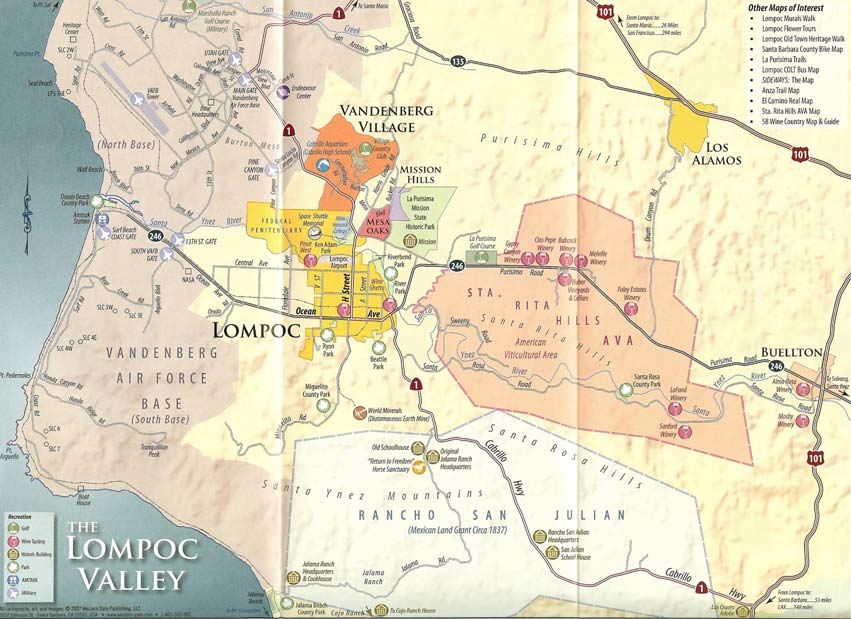 Perhaps Brewer-Clifton, which was featured in MacInerney’s article, is the most visible producer of Sta. Rita Hills Chardonnay, but there are a number of others to recommend including Alma Rosa, Au Bon Climat, Babcock, Clos Pepe, Fess Parker, Melville, and Sea Smoke. I recently visited Sea Smoke and drank the 2008 Chardonnay out of magnum, a beautifully balanced California interpretation of Chablis that will be sold to customers for the first time. In the past, Sea Smoke only bottled Chardonnay with the “Gratis” label, and gave it away to the winery’s best customers. Prices for Sta. Rita Hills Chardonnays are on the high side, with premium bottlings ranging from $35 to $70, and many wines only available to mailing list or wine club members. I have learned a few tricks about enjoying Chardonnay. First, never serve Chardonnay too cold or you will squelch the aromatics and flavors. A cellar temperature of 60 degrees is about ideal and let it warm in the glass over time. (Check feature on page 33 for more on this). Second, use a Burgundy style glass of the type you would use for Pinot Noir. Do not use the smaller Chardonnay designated glasses made by stem producers. The larger bowl releases more of the wine’s aromas and allows for more swirling to aerate the wine. Third, Chardonnays tend to oxidize more slowly than red wines, so re-corking and placing the wine back in your cellar will prolong the life of the wine for several days.
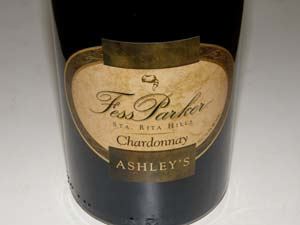 2008 Fess Parker Ashley’s Sta. Rita Hills Chardonnay 14.3% alc., $22. Ashley’s Vineyard was planted in 1997 and was named after Fess Parker’s daughter. The vineyard has been sold to Foley and is now split into Lindsay’s Vineyard (red varieties) and Courtney’s Vineyard (white varieties including Mt. Eden clone of Chardonnay), both part of Rancho Las Hermanas, but Fess Parker retains the “Ashley’s” designation. The vineyards span 213 planted acres. · Straw color in the glass. Nicely appointed nose featuring scents of green apple, pear, cinnamon spice, and a hint of oak toast. Very tasty essence of white stone fruits in a seamless style with a well-proportioned acid backbone. Very clean on the finish, drawing the drinker to take another sip. California Chardonnay at its finest. Because of the name, many wine geeks do not take the winery seriously, but I am here to tell you that this is a label worth exploring for all of its varietals.
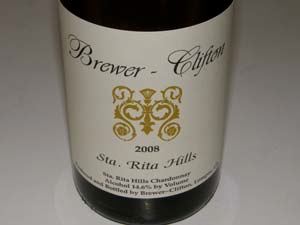 2008 Brewer-Clifton Sta. Rita Hllls Chardonnay 14.6% alc., 1,296 cases, $36, wax closure. · Straw color in the glass. Very shy and opens slowly revealing aromas of lemons, wax, and cheese. Pleasant but nondescript and rather austere with a citrusy, waxy and toasty core. The alcohol gives the wine body and creaminess, the bright acidity contributes a brisk finish. Seems like a lot of wine with little flavor (a Big Mac without the secret sauce). Decent.
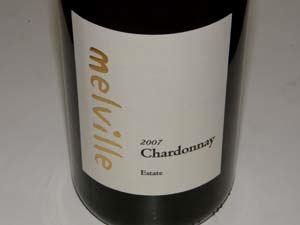 2007 Melville Estate Sta. Rita Hills Chardonnay 14.9% alc., $20. · Straw yellow in the glass. Appealing aromas of buttered toast, honey and lemon curd. Rich and bright on the palate with a tasty core of green apple, peach and honeydew flavors and toasty oak in the background. Hi-tone acidity brightens the finish. Well-endowed and full-bodied, this is very California at heart. Very good.
2007 Brewer-Clifton Rancho Santa Rosa Sta. Rita Hills Chardonnay 14.6% alc., 284 cases, $45, wax closure. Clones 4 and 76. · Straw color in the glass. The nose draws you in with aromas of apple pie, citrus fruits, buttered toast and caramel. The flavors echo the aromas. Luscious and well-endowed, possessing zippy acidity and a crisp finish. Very good.
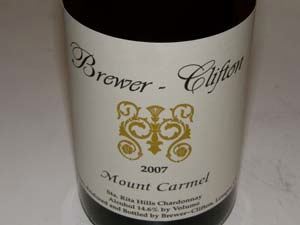 2007 Brewer-Clifton Mount Carmel Sta. Rita Hills Chardonnay 14.6% alc., 480 cases, $65, wax closure. Planted in 1991 by Ron and Nancy Piazza, this monopole vineyard is overseen by vineyard manager, Francisco Ramirez. Of the twenty acre parcel, six are planted to the Wente clone. · Clear, straw color in the class. Restrained aromas of white peaches, roasted nuts and brioche. Appetizing peach and lemon fruit with a hint of papaya and noticeable citrus peel on the steely finish. Seamless with faint tannin and admirable persistence on the finish. Very good.
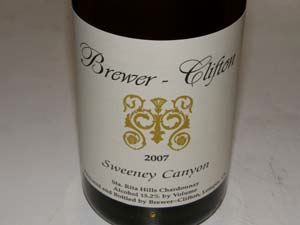 2007 Brewer-Clifton Sweeney Canyon Sta. Rita Hills Chardonnay 15.2% alc., 120 cases, $70, wax closure. Twelfth bottling from this site. Planted on its own roots to a Wente selection and dry farmed. · Light straw color in the glass. Distinctive aromatic profile of dried herbs, candle wax and cut flowers. Lovely flavors of peaches and nectarines with a faint note of oak in the background. Slightly creamy and more demure than the Mount Carmel and Rancho Santa Rosa bottlings with a better fruit and acid balance. No sign of alcohol.
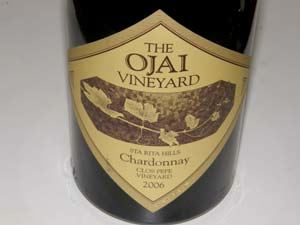 2006 The Ojai Vineyard Clos Pepe Vineyard Sta. Rita Hills Chardonnay 14.0% alc., $35. From renowned winemaker Adam Tolmach. Clone 76. · Straw yellow color in the glass. The aromas are dominated by oak-derived notes of toast and vanilla which tend to blow off over time exposing the mineral-imbued citrus fruits. Delicious on the palate, soft and smooth, with pleasing flavors of white peaches, lemons and pink grapefruit, leaving a lasting impression on the persistent and high-spirited finish. A high-class wine singing in perfect harmony. Very good.
Sips of Pinot Noir2008 Esoterica by Kent Rasmussen Carneros Pinot Noir 13.5% alc., $17. · Moderately dark reddish-purple in the glass. Ripe to overripe dark fruits on the nose with tones of earth, sap and red hard candy. Moderately rich and savory on the palate with a generous offering of earth-kissed plum and black currant fruit with a slight roasted and herbal quality. Very soft in the mouth and easy to drink. Good.
2008 Cep Sonoma Coast Pinot Noir 13.8% alc., $24. A second label from Peay Vineyards. · Initially the nose is attractive with aromas of fresh berries, but as the wine sits in the glass, a subtle smokiness comes out. The medium-weighted core of berry fruit has underpinnings of tar and ash. Silky smooth and tries to please, but the smoke affectation detracts. Good (-)
2008 Gary Farrell Carneros Selection Chardonnay 14.1% alc., pH 3.41, 933 cases, $32. Released February 2010. Sourced from unique blocks at Ramal Vineyard. Barrel fermented in 33% new French oak barrels for 7 months. · Clear and straw colored in the glass. Austere aromas of lemon juice and fresh cut grass. Well-endowed with moderately rich flavors of canned peaches, honeydew and roasted nuts which linger on the finish. Nothing out of place. Good.
2008 Navarro Vineyards Deep End Blend Anderson Valley Pinot Noir 13.8% alc., $38 (futures price). · Moderately dark ruby color in the glass. Nice fruity aromas of plums and blackberry jam with a hint of herbal oak and smoke. Tasty darker fruit core with a tarry, smoky, ash edge. Nicely crafted with lively acidity and some grape tannins to shed. One of the better smoke affected 08s from Anderson Valley. Decent. Note: Navarro made the welcome gesture of sending out a bottle of this wine free to all buyers of previous vintages (including myself) to allow them to evaluate it and decide if they wanted to buy the wine despite the vintage challenges.
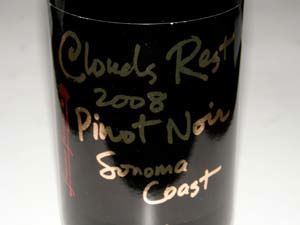 2008 Cloud’s Rest “Femme Fatale” Sonoma Coast Pinot Noir 14.2% alc., $40. Estate grown. · Moderately dark reddish-purple color in the glass. The nose is tres Pinot with fresh black cherry and dark berry aromas. Generous dark red cherry and berry fruit with a lovely spice accent. The fruit really brings the palate to attention and persists on the finish. Bright acidity adds to the drinkability. This wine will find wide appeal. Very good (+).
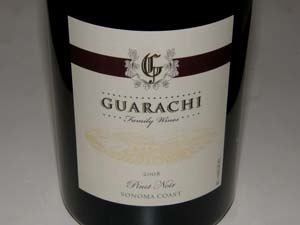 2008 Guarachi Family Wines Sonoma Coast Pinot Noir 14.8% alc., $40. One of the heaviest bottles I have ever lifted! · Moderately dark garnet color. Alluring perfume of spiced fresh berries with a minty garnish. Tasty and smooth in the mouth with plenty of dark cherry and berry intensity and a touch of cola, all wrapped in modest sinewy tannins. The wine’s sensual texture speaks Pinot. Very good.
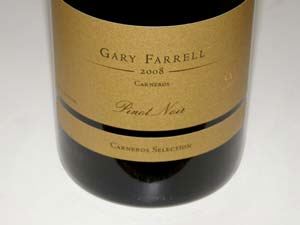 2008 Gary Farrell Carneros Selection Pinot Noir 14.2% alc., pH 3.50, 932 cases, $45. Released April 2010. Sourced from Ramal Vineyard in Carneros. Aged in 44% new French oak barrels for 9 months. Clones 667, Pommard 5, 828, 115, Swan. · Needs time in the glass to unfold, revealing attractive scents of black cherries and blackberries with a well mannered touch of smoky oak. Earthy, herbal and flush with dark berry fruits, this silky wine aims to please with a seamless backbone of restrained tannins and a proper grip of acid. Very good.
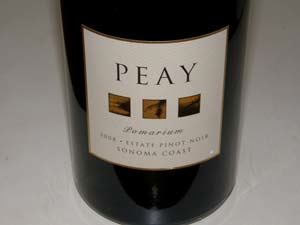 2008 Peay Pomarium Estate Sonoma Coast Pinot Noir 14.2% alc., $53. The name refers to “apple orchard” and is pronounced “po-mare-ee-um,” as a nod to the days when the hill where the vineyard sits was planted to apples. · Moderate reddish-purple color in the glass. Nicely composed aromatics with plenty of fresh cherries and mixed berries accented by forest floor and mountain air. Hearty and fairly bold attack of berry and black cherry fruit augmented by oak. Earthy and savory with a faint aftertaste of smoke on the persistent finish. Still has some tannins to shed and should improve over time, assuming the smoke affect doesn’t become accentuated. Very good.
2007 Henry of Pelham Family Estate Ontario Canada Pinot Noir 13.0% alc., $17. Imported by Beck Wines & Spirits, San Francisco, CA. · Moderately deep reddish-purple color in the glass. Starts out with marked sulfur notes of rotten eggs, obscuring the underlying aromas of dark fruits, pine tar and oak char. Robust black cherry fruit with an underlying earthy note, wrapped in flamboyant sandy tannins. Seems over-sulfured. Unsatisfactory. This winery was a featured winery at this year’s IPNC, so I suspect this was not a representative bottle.
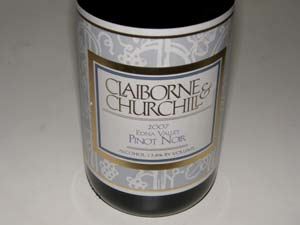 2007 Clairborne & Churchill Edna Valley Pinot Noir 13.8% alc., $20. From a family winery established in 1983, specializing in Pinot Noir, Riesling and Gewürztraminer. · Moderately intense garnet color. Darker fruits are featured on the nose along with notes of cherry cola, picking up more oak and funkiness with time in the glass. Tasty fruit but oak permeates this wine and takes away from the experience for me. Otherwise it is fine, with good acidity and a tangy persistence of citrus peel on the back end. Decent.
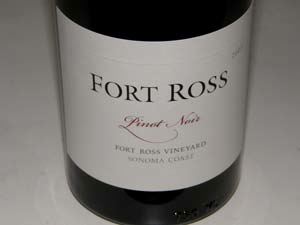 2007 Fort Ross Fort Ross Vineyard Sonoma Coast Pinot Noir 14.5% alc., $30. · Minty, oaky aromas with alcohol peaking out. Rich and full on the palate with delicious flavors of black cherries, plums, oak toast and a hint of white pepper. A disjointed wine now with the flavors trumping the aromas. Worth visiting in another year. Good (+).
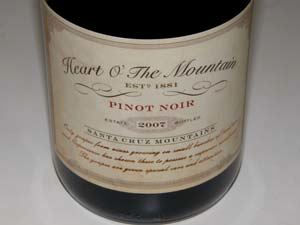 2007 Heart O’ The Mountain Santa Cruz Mountains Pinot Noir 14.8% alc., pH 3.56, 490 cases, $48. Clones 777, 667 and Pommard. Aged 18 months in French oak. · Medium garnet color. Deep, dark, very ripe fruit perfume with hints of forest floor and sawdust. A big gulp of purple fruit (black plums, elderberries, blackberries) that dances lightly on the palate, drinking easily by virtue of mild fine-grain tannins. The sweet, velvety mouthful of fruit will find appeal. A faint hint of alcohol peaks out on the finish. Very good.
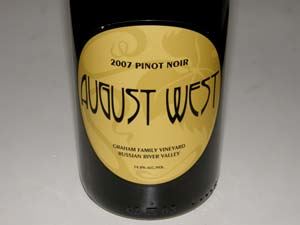 2007 August West Graham Family Vineyard Russian River Valley Pinot Noir 14.8% alc., $50. · Medium garnet color in the glass. Charming scent of red cherries accented by gentle oak toast. Fruity and tasty with a pleasing fullness on the palate. Harmonious with gossamer tannins and a good grip of acidity. A solid, but not emoting wine now but should improve over time. Good (+).
Pinot BriefsBien Nacido Vineyard to Produce Own Label Dating to 1973, when the first grapevines were planted by Mexican immigrants, Bien Nacido has supplied grapes to many big names in California including Au Bon Climat, Gary Farrell, Landmark, Lane Tanner, Longoria, Qupe, Tantara, and Villa Mt. Eden. Bien Nacido Vineyard was recently honored as “California Vineyard of the Year” by the California Exposition and State Fair. Beginning with the 2007 vintage, the Millers (Steve, Nicholas and Steve’s second son, Marshall) will release their first wines under the Bien Nacido Vineyard label including a 2007 Pinot Noir and a 2007 Syrah. A 2008 Chardonnay from Solomon Hills Vineyard will follow in 2008. Visit www.biennacidovineyards.com.
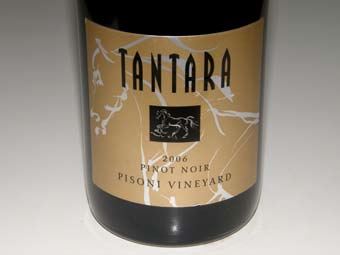 Tantara Pinot Noirs are tops in 2008 Recently at the “Pinot Camp” I organized for a small group in the Santa Rita Hills, we dined with Jeff Fink of Tantara at Hitching Post II restaurant in Buellton. We tasted through most of his 2008 lineup of wines. The 2008 Bien Nacido Vineyard Chardonnay ($38) was bright and juicy with appealing citrus, stone fruit and caramel flavors. The 2008 Bien Nacido Vineyard Adobe Pinot Noir ($48) is a bit big-boned and tannic for me, but had fans at the table. The 2008 La Colline Vineyard Arroyo Grande Pinot Noir ($48) was terrific with plenty of red and black fruit, but light on its feet with a generous finish. The 2008 Lindsay’s Vineyard Sta. Rita Hills Pinot Noir ($55) was a step up in quality, but a step down in accessibility, requiring some more bottle age to mature. The 2008 Pisoni Vineyard Santa Lucia Highlands Pinot Noir was a big hit with those that were eating steaks. The wine was quite soft and restrained for a Pisoni and I loved it. Jeff also shared a clean skin bottle of Pinot Noir that was 90% whole cluster from a barrel of Dierberg Pinot Noir he was experimenting with and not offered for sale. Everyone went crazy for the spiciness of this wine. The Tantara lineup is very solid and highly recommended. Visit and taste with Jeff sometime at the winery which is located at Bien Nacido Vineyard. Wines may be ordered at www.tantarawinery.com or by calling 805-938-5051. As a side note, Jeff also crafted two proprietary custom blends for Wally’s in West Los Angeles: the 2008 Tantara Cuvée Maria Pinot Noir (200 cases, $29.99) is a blend of 44% La Colline Vineyard, 37% Solomon Hills Vineyard and 19% Bien Nacido Vineyard. The 2008 Tantara Cuvée Lucia Pinot Noir (75 cases, $49.99) is a blend of 67% Pisoni Vineyard and 33% Brousseau Vineyard. The latter is not for the faint of heart. For information or to buy, visit www.wallywine.com. Striking Decanter Newton Vineyard has collaborated with blown glass artist John Pomp to produce a decanter called The Touch. 100 limited edition pieces are mouth blown from 30% recycled glass. The decanter has a distinctive dimple on each side that creates a natural fit for the hand. $500 each. Visit www.newtonvineyard.com.
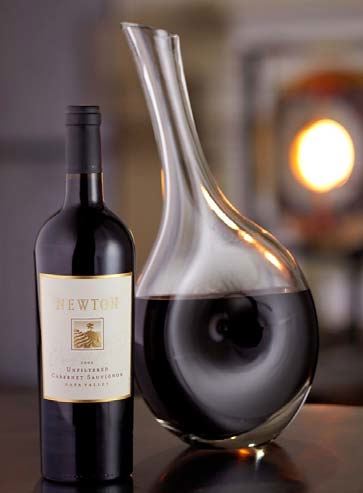 Pour Champagne at a Slant French scientists have demonstrated that pouring Champagne at a slant, as is typically done for beer, preserves more of the tiny gas bubbles that contain Champagne’s aroma and flavor. The study, “On the Losses of Dissolved CO2 During Champagne Serving,” was published in the Journal of Agricultural and Food Chemistry.
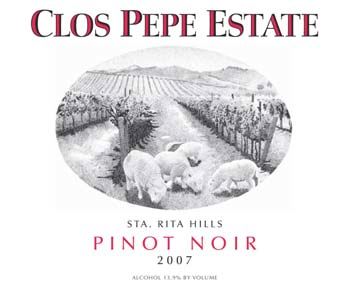 Clos Pepe Vineyard Open House The Pepes really know how to throw a party at their Tuscan themed estate and this year’s “10th Annual Allocation Event and 2010 All-Star Allocation Barrel Tasting” was quite a blast. Hypersonic winemaker Wes Hagen must have come up with this hyperbolic title for the event, as Stephen and Catherine Pepe are very polite and soft spoken. Wes was holding court with barrel samples of his 2009 Clos Pepe Pinot Noirs and I thought enough of the wines to buy four bottles of the Clos Pepe Estate Vigneron Select ($44 futures price). I also snagged two bottles of the 2009 Clos Pepe Estate unoaked Chardonnay ($22 futures price). Older vintages were offered for tasting and purchase, all of which went down nicely with the delicious wood-burning-oven pizzas offered. Join the Clos Pepe admirers by buying some wine, and receive an invitation to next year’s event. Northwest Wineries are Tapping into the Chinese Market Earlier this year, a delegation from Washington and Oregon signed an agreement to promote wines in Hong Kong. Hong Kong’s wine imports have soared since it eliminated an 80% excise tax in 2008. Hong Kong is now the fourth largest export market for United States wines behind Canada, The European Union and Japan, but so far, Oregon and Washington wine exports to the Orient are very small. Hong Kong’s largest specialty chain, Watson’s Wine Cellar, does sell Oregon’s Erath and Argyle labels. Associated Press reported that Wine Intelligence estimates the number of Chinese who drink imported wine will grow to about 50 million in 15 years, about the same number of people in the United States who drink imported wine. Andy Tan, who is Sales Director of Fine Wine Sales for ASC Fine Wines in Shanghai, China, recently told me that the Chinese have potentially the world’s largest fine wine market but the “market is still in its infancy.” He said, “Wine is perceived by brand instead of the true genie inside the bottle. So apart from Bordeaux or Cabernet, and Burgundy from DRC, Pinot Noir is not as popular here.” He went on to tell me, “This is a land “peeing” with Cabernet, not “pee-no wah!” Andy, himself, is constantly craving for good Burgundy or good Pinot Noir from Sonoma Coast and Sonoma Mountain. Noted Sommelier Larry Stone to Head Evening Land in Willamette Valley According to OregonLive.com, Larry Stone, who left the restaurant business in 2005 to manage Rubicon Estate, will become the new General Manager at Evening Land in Oregon. Evening Land produces Pinot Noir and Chardonnay from vineyards in Oregon’s Willamette Valley (for example, they own Seven Springs Vineyard), California’s Sonoma Coast and Santa Rita Hills, and Burgundy. Stone will work with consultant Dominque Lafon and continue his own Sirita Winery project in Napa Valley. New Food & Wine Event for Central Coast The inaugural “SUNSET - Savor the Central Coast” will be held September 30-October 3, 2010 at Santa Margarita Ranch and locations throughout San Luis Obispo County. The event will highlight the talents of Central Coast winemakers, chefs and artisan food producers with culinary tours, celebrity chef demonstrations, winemaker dinners, winery and harvest tours, Best-of-the-Best Food Carts, and many other activities. The Concert and Fireworks Finale will feature Chris Isaac. For event details and tickets, visit www.savorcentralcoast.com. Marcassin to Locate Winery in Windsor Helen Turley plans to build a winery for her Marcassin Vineyard brand this summer in Windsor. 80% of Marcassin Pinot Noir and Chardonnay, ranging from 2,500 to 3,000 cases a year, is sold to mailing list customers for $125 a bottle. The mailing list’s waiting list is hopelessly long. Plans call for a new 10,000 foot facility in a new industrial park off Conde Lane in Windsor adjacent the DuMOL winery. Marcassin wines have been produced at Martinelli Vineyards & Winery since 1992 and Turley has been the consulting winemaker for Martinelli until this year. Bryan Kvamme was named winemaker at Martinelli in 2008. The Windsor winery is approved for 10,000 case production by 2015, but there are no plans to become that large. Inman Family New Winery & Tasting Room Kathleen Inman is proud to announce that she has said goodbye to her industrial unit in Windsor and moved to a new ecologically friendly winery and tasting room at Olivet Grange Vineyard. The tasting room is open Friday-Sunday from 11:00 to 4:00 at 3900 Piner Road in Santa Rosa. Visit www.inmanfamilywines.com for more information. Benton Lane Wins Top Award at SF International Wine Competition The San Francisco International Wine Competition is the largest wine competition in the world, evaluating wines from 27 countries and 28 states, a total of 3,897 entries. Benton Lane was the only Oregon winery entry to win a Gold Medal for its 2008 Willamette Valley Estate Pinot Noir and 2008 Williamette Valley First Class Pinot Noir. Winemaker Greg Linn (Ambullneo) Gives a Math Lesson “The prevailing wisdom is one cluster equals one glass of wine, but not all clusters are created equally. The average cluster when fully mature has approximately 75 grapes on it. Four clusters or 300 grapes equal one bottle of wine. Each vine in the vineyard has approximately 40 clusters. An average vine produces 10 bottles of wine or almost a case. So, how much wine or grapes in a barrel? The answer is 1200 clusters = 60 gallons or one barrel. But, hold on! Fine wine goes through severe sorting. Also, the amount of juice in a Cabernet grape is much higher in volume than that of a Pinot Noir grape. So the type of grapes come into play. After three drops of fruit in the vineyard and sorting at the tables following harvest, we are often left with, on the high side, 12 clusters per vine and, on the low side, 6 clusters per vine. That’s with the smallest of clusters used in fine Pinot Noir. Remember, that is before any barrel selection, so I will leave that math to you because I’m now confused. The point is, it takes great sacrifice to make great wine, so drink less, but drink better.” Wine on Tap According to Food Arts magazine, the latest trend in restaurant wine service is offering premium wines in steel kegs. The first large-scale application of wine on tap occurred four years ago at TWO Urban Licks restaurant in Atlanta. Forty-two wines are offered on tap, split equally between reds and whites. The steel torpedo kegs traditionally used for boutique beer are housed in a glass and steel temperature controlled tower and are protected with a blanket of argon gas as they deplete. About 90% of wine sales come from wine on tap at the restaurant. Wineries participating include Au Bon Climat, R. Stuart and Company, La Crema, and Steele Wines. Tap wines are offered by the half glass, glass, 10-ounce mini decanter, 20-ounce decanter, and 42-ounce decanter with three tiers of pricing. TAP, another restaurant owned by Concentrics Restaurants, opened in Atlanta in 2007, and serves 16 wines on tap. The Tavern at Lark Creek in Larkspur, California offers kegs of wine from Truchard Vineyards, Saintsbury, Paul Dolan Vineyards and Qupé Wine Cellars. By saving about 35% on the purchase price, Lark Creek can offer glasses of wine that sell at other restaurants for $13, for just $8 or $9. Single kegs also offer an ideal way to offer special wines that are produced in very small quantities or even exclusive wines sold only to restaurants.
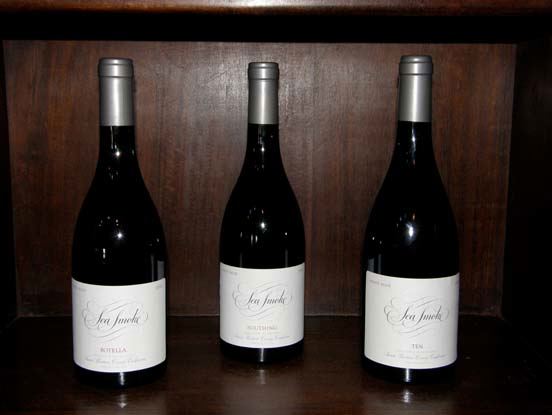 Sea Smoke I visited Sea Smoke recently as part of a weekend “Pinot Camp” in the Santa Rita Hills. We admired the vast 350-acre property of which 100 acres is planted to Pinot Noir and 10 acres to Chardonnay. There are 10 different clones of Pinot Noir planted (no heritage clones included). New winemaker, Don Schroeder has worked himself to the top with the departure of Kris Curran after starting at the winery as a cellar rat several years ago. He is refining the Sea Smoke style, emphasizing less alcohol and new oak (down from 100%). The new 25,000 square foot winery facility in Lompoc near Pali Wine Co. is very impressive. Winemaking typically involves the following. The grapes are 100% de-stemmed, and after fermentation, an extended maceration of 5 to 30 days is carried out, accounting in part for the massive extraction of the Sea Smoke Pinot Noirs. The wines are typically aged 18 months in barrel without racking. Sea Smoke produces three Pinot Noirs: Botella which is the winery’s basic workhorse bottling, Southing which is more complex, nuanced and elegant, and Ten, which is the boldest and biggest structured wine in the lineup. The wines are sold almost entirely through a mailing list which currently has a waiting list. Visit www.seasmokecellars.com.
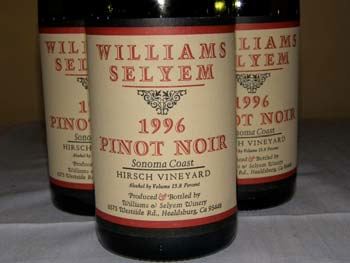 Williams Selyem Opens New Winery This iconic Westside Road Pinot Noir producer has moved into a new modern winery overlooking the Russian River Valley. Williams Selyem wine list members can visit by appointment and picnic on the grounds, but the visitors center is not open to the public. On another front, Williams Selyem will not be allowed to use the “Litton” designation on their Litton Estate Pinot Noir after 2008 due to a name challenge. The vineyard will be renamed Williams Selyem Estate Vineyard and the wine produced from this vineyard will carry that designation.
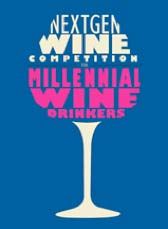 How to Rope Millennials into Wine Wine consumption among the millennial population has increased 38% in the past year according to the Wine Market Council. The Millennials are also known as Generation Y, Generation Next or Net Generation. There are no precise dates when the Millennial generation starts and ends, but generally ages range from 16 to 33 in 2010. The 70 million Millennials are the second largest U.S. consumer group in history (the Baby Boomers generation had 78 million), but have grown up more exposed to wine than the older Baby Boomer generation. I know looking back at my life as a Baby Boomer, I did not begin seriously understanding and consuming fine wine until I had a solid job with spendable income and this did not occur until I was over the age of 35. In June, the NextGen Wine Competition for Millennial Wine Drinkers was held in Santa Rosa and included a category for winemakers under 35 and all the judges were wine professionals in the Millennial age group. Even though the Millennials are fast becoming interested in wine, most of the professionals who tell people what to drink are in their 50s and 60s creating a big disconnect. The result is that Millennials don’t give much credence to wine scores. The competition indicated that Millennials are not looking for big, powerful wines and are more willing to experiment with many different styles of wine. They embrace online information, Quick Response technology, and social networking to find wines to drink. The competition’s best of show wine was a non-vintage Barefoot Cellars Moscato ($6) and the best of show in the young winemaker’s division was a 2007 Charter Oak Zinfandel ($42). A tasting of 150 medal-winning wines from the first NextGen Wine Competition for Millennial Wine Drinkers will be held at Herbst Pavilion, Ft. Mason, San Francisco on October 21. Visit www.nextgenwinecomp.info. I have noticed that at major wine festivals I attend such as IPNC and WOPN, there are very few Millennials, presumably because the events require too much commitment in weekday time, travel and expense, so smaller, one day events may be more suitable. San Francisco Tax on Alcoholic Beverages As reported in SFGate.com (August 5, 2010), Supervisor John Avalos has proposed legislation that would charge wholesalers and certain distributors of alcoholic beverages a fee of just under 6 cents for every ounce of alcohol sold. The fee would add approximately 4.5 cents to a 6-ounce glass of wine. The justification as voiced by some was that it would help curb human and financial costs of excessive alcohol use, but I see it as simply another attempt of big government to get their hands on more money at the expense of small business. Fortunately, the mayor does not support the legislation. Greg La Follete Launches New Label Acclaimed winemaker Greg La Follette (Tandem, De Loach, Londer, Flowers) has started an eponymous new label, La Follette. The new venture is a partnership between Greg and Wine Creek, a small multi-brand wine business owned by the Kight family. The new label will concentrate on cool-climate Pinot Noir and Chardonnay “at a price that more people can afford.” A Grand Release Dinner will be held Saturday, August 28, 2010 at Van Der Kamp Vineyard in Santa Rosa. Visit www.lafollettewines.com.
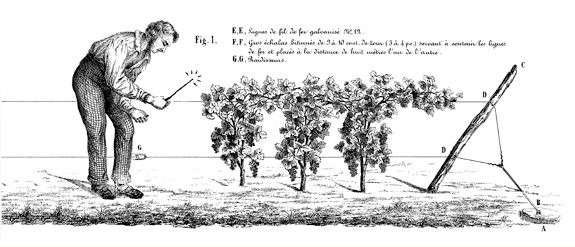
Doctoring Wine for Optimum Drinking
A good run or a few sets of tennis can be very dehydrating this time of year. Mix four parts water to one part white wine for a thirst-quenching tonic. It refreshes because of the wine’s acidity, and tastes more interesting than lemonade, particularly if the wine is pretty good. Serve the rest of the wine with dinner. This tip comes from Clos Du Val and French born winemaker, Bernard Portet. If you are on a picnic at the beach and the white wine is a little too warm, it will taste too sweet. Add some ice cubes to it. Suppose it is sweltering, you are in the backyard pulling some hamburgers off the grill, and the Pinot Noir Rosé is at room temperature. Slip some ice cubes into it. If your tastes run to fine Cabernet Sauvignon, but the wine in your glass tastes massive and hard, thin it out with water, titrating the water until it tastes perfect. A master sommelier, Rene Chazottes, taught me this trick many years ago when I actually drank Cabernet Sauvignon, and believe me, it works. If the wine cost you a day’s wages and you cannot bear to impugn the pedigree of the wine, use a little Sauvignon Blanc instead of water. What do you do when you have the a wine that is too cold? Nothing bristles the hair on my neck more than when dining in a restaurant and the fine Chardonnay I have ordered is brought to the table at refrigerator temperature along with an ice bucket. Cold masks the deficiencies of a white wine, accentuating its crispness, but kills the taste of a complex wine. There is a solution if you can get the waiter to do it for you. Ask him or her to put the bottle of wine into that silent chamber called a microwave and 10 seconds later, like a client at a tanning salon that is flush with radiation, the wine will be 4 degrees warmer. The same can be done for a red wine that has a slight chill. The practice is not widespread and most sommeliers won’t admit to doing it. Nuking your wine will not hurt it as long as it is not overdone. The microwave oven is heating the water that is the main constituent of wine. According to Christian E. Butzke, an associate enologist at the University of California at Davis, exposing the wine to 10 seconds of microwave radiation will not produce any chemical reactions other than warming the water in the wine, and nothing will be harmed. The phenolic structure of the wine is not disturbed. The process is awkward because you associate the microwave with TV dinners. Although most winemakers are reluctant to endorse this technique for fine wines, the objection is mainly philosophical rather than rational. Before using the microwave, the metal capsule must be removed from the top of the bottle. It is not necessary to remove the cork, since warming the wine a few degrees will not significantly expand the volume of air between the cork and the wine. Set the microwave power on high. Every 5 seconds of microwave warming will elevate the wine’s temperature by two degrees. You may prefer to pour the wine into a glass or small carafe first, especially if the wine is very cold, as the wine will be brought up to room temperature more easily with little microwave exposure. In this case, do not exceed 10 seconds of nuking. Of course there is a very simple way to bring chilled wine up a few degrees in temperature. Simply let it sit at room temperature for 15 to 20 minutes. This technique, known to the Romans, produces spectacular results with no effort. There are many times, however, when you can’t wait 15 minutes, and that is when the microwave comes in handy. The recommended serving temperature for fine wine is 55 degrees Fahrenheit for white wines and 65 degrees Fahrenheit for red wines. The temperature you prefer is your own patrimony, and the use of water, ice cubes or a microwave can allow you to reach your comfortable drinking temperature range more quickly. |